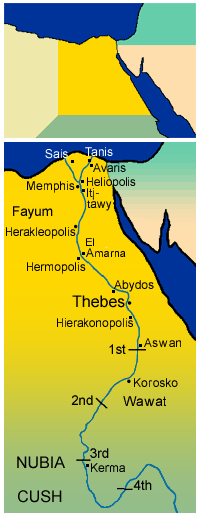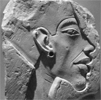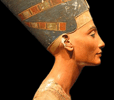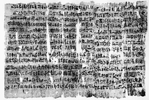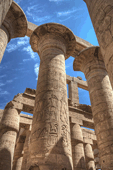| c.1550 | 2nd INTERMEDIATE PERIOD ends. Began 1786. | 1580 BHoE, RAH 72 1575 GEoP 1570 B76 17-934, Clay, FLAP, IDB 2-243, Murn, PW 15, Sdl 1-24, TTPC, resh, tig 1567 B76 11-896, ISBE 2-40, JIAE, WPOT 1558 SHWC 22 1552 FHBC 218, Grim 1550 Shaw, ktut, phou, pic, wikP 1546 SOTS 44, WERE 1540 ae 1534 nar |
| NEW KINGDOM begins until 1070. |
| c.1550 | 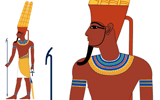 Chief god of Egypt, Ra from 2490, fused with AMUN until 1347 as AMUN-RA. Amun-Ra (16th to 11th centuries) is a transcendental, self-created creator deity, champion of the poor or troubled and central to personal piety. His position as King of gods develops to the point of virtual monotheism, where other gods become manifestations of him. Amun-Ra is the most widely recorded of Egyptian gods.
Chief god of Egypt, Ra from 2490, fused with AMUN until 1347 as AMUN-RA. Amun-Ra (16th to 11th centuries) is a transcendental, self-created creator deity, champion of the poor or troubled and central to personal piety. His position as King of gods develops to the point of virtual monotheism, where other gods become manifestations of him. Amun-Ra is the most widely recorded of Egyptian gods. |
art: Jeff Dahl reign of Ahmose wikAmn |
| c.1550 | 18th DYNASTY begins until 1293. Located at Thebes (modern Luxor) until 1390. |
1580 RAI2, BHoE 225 1576 RAI3 1575 Sag, GEoP 443, CWH 1570 B76 17-934, Clay, lveg, pic 1567 CAH 2.1, JIAE 1552 Grim, MRDK 1550 CVK, Shaw 1540 ae 1534 nar |
| c. 1550 c. 1550 |
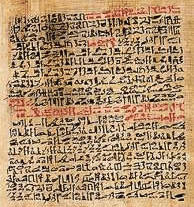 Ebers Papyrus a 110-page scroll 20 meters long written in hieratic.
Ebers Papyrus a 110-page scroll 20 meters long written in hieratic.Λ MEDICAL V text, probably a copy of older documents containing prescriptions dating back possibly to 3700. Contains 700 magic formulas and folk remedies, several eye washes. Covers: mental disorders, depression, dementia, contraception, diagnosis of pregnancy and other gynecological matters, intestinal disease and parasites, eye and skin problems, dentistry and surgical treatment of abscesses and tumors, bone-setting and burns. Depression and dementia are covered. Shows that physicians prescribe diets, fasts, massage. Some practice hypnosis. Λ ANATOMY: Accurately describes circulatory system and heart function. "46 vessels go from the heart to every limb, if a doctor places his hand or fingers on the back of the head, hands, stomach, arms or feet then he hears the heart. The heart speaks out of every limb." Ignorant of kidney function, it makes the heart the meeting point of vessels which carry all body fluids. (See Alcmaeon 490) Dicsovered 1872. |
photo pub dom 1700 TTPC 16-1500 mxfld 1550 B76 III-768, IDB 1-488, TTS, hsnf, rfil, 1500 IDB 1-849, TTT, wikEbrs, wikEMP no date: hls |
| Prescribes medical marijuana applied directly for inflammation. | 1550 wikMedCan |
| c.1550 | SOAP: Ebers Papyrus says Egyptians bathed regularly and combined animal and vegetable oils with alkaline salts to create soap. (See Celts 750, Phoenicia 600) | 1550 wikSop |
| c. 1550 | 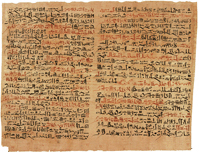 Edwin Smith Surgical Papyrus , oldest surgical text, lists 48 traumatic injury cases written in hieratic script with a description of the physical examination, treatment and prognosis of each. Based on material from 1,000 years earlier.
Edwin Smith Surgical Papyrus , oldest surgical text, lists 48 traumatic injury cases written in hieratic script with a description of the physical examination, treatment and prognosis of each. Based on material from 1,000 years earlier.Λ MEDICINE V, already advanced from before Hyksos period, makes further advances: closing wounds with sutures (for lip, throat, and shoulder), preventing and curing infection with honey and mouldy bread, stopping bleeding with raw meat. Immobilisation is advised for head and spinal cord injuries. Controling power of brain is acknowledged. 1st known description of cranial sutures, meninges, external surface of the brain, cerebrospinal fluid, and intracranial pulsations. Heart, vessels, liver, spleen, kidneys, ureters and bladder are recognized, and that blood vessels connect to the heart. Other vessels are described, some carrying air, some mucus, while 2 to the right ear are said to carry the breath of life, and 2 to the left ear the breath of death. Magic is resorted to in only one case. |
photo {{PD-US}} 1600 hsnf, rfil, wikEMP 1550 MCAW 29, TTS, TTT |
| Appears to be a copy of a 2500BCE manuscript. |
| c.1550 | Egyptian love poem: "It is seven days from yesterday since I saw my love, and sickness has crept over me. My limbs have become heavy. I cannot feel my own body. If the master-physicians come to me, I gain no comfort from their remedies. And the priest-magicians have no cures. My sickness is not diagnosed. My love is better by far for me than my remedies. She is more important to me than all the books of medicine." |
1550 hls |
| c.1550 | Λ BEER buried in tombs of pharaohs for afterlife consumption. (See China 1475) | 1550 bracdm |
| c.1550 | Book of the Dead V Not a single book, but a type of text used from the beginning of the New Kingdom to c.50. Generally written on papyrus, they consists of magic spells intended to assist a dead person thru the underworld, so that he might avoid a lake of fire, often mentioned, and enter a pleasant afterlife. Includes texts drawn from earlier Pyramid Texts and Coffin Texts. Placed in the coffin or burial chamber of the deceased. (See Ani) | 1600 bk 1575 MCAW 29 1550 wikBotD no date: wikLF |
| c.1550 |  PYRAMID of AHMOSE: Not a tomb, but a cenotaph for Ahmose-I at the necropolis of Abydos. It was the only royal pyramid built in this area. Made of sand and rubble kept in shape only by the limestone casing. It had a base length of 52m and was about 40m high. The slope was 60°. Today only a pile of rubble about 10m high.
PYRAMID of AHMOSE: Not a tomb, but a cenotaph for Ahmose-I at the necropolis of Abydos. It was the only royal pyramid built in this area. Made of sand and rubble kept in shape only by the limestone casing. It had a base length of 52m and was about 40m high. The slope was 60°. Today only a pile of rubble about 10m high. |
photo Wannabe Egyptologist no date: wikPA |
| c. 1546 | AHMOSE dies. 1st pharaoh of 18th (Theban) Dyn from 1550. Buried in the Dra Abu el-Naga area, but his tomb is unknown. His mummy will be found at Deir el-Bahri TT320 with 44 others. Son AMENHOTEP-I succeeds to 1528. Widow Ahmose Nefertari is regent. |
1557 BHoE 252, RAH 73 1550 CWH, GEoP, RAI2, Sag 1546 B76 6-472, 17-934, CAH 2.1, Clay, FLAP 87, ISBE 2-41, JIAE, Murn, RAI3, WERE, bk, pic, resh, scar, tig 1545 lveg 1533 SHWC 22 1526 FHBC 218, Grim 1525 CVK, Shaw, ktut, phou, wikP 1524 DMoN 1515 ae 1514 treg 1508 nar |
| c.1540 | AMENHOTEP-I, 2nd pharaoh of 18th (Theban) Dyn 1550-26, invades NUBIA, colonizes it, brings captives back to Thebes. | 1550 MCAW 28 yr 8 Shaw 213 no date: TTPC |
| c.1540 -30 | Invasion into Levant or beyond by Amenhotep-I cannot be confirmed, but is not likely. | no date: wikAmn1 |
| 1537 or 1517 | SOTHIS helical rising is noted in 9th day of 3rd month of NINTH YEAR of AMENHOTEP-I. 1537 if observed from Memphis or Heliopolis. 1517 if observed from Thebes. |
wikAmn1 |
| c. 1528 | AMENHOTEP-I dies. 2nd pharaoh of 18th (Theban) Dyn from 1550. 1st pharaoh to separate his mortuary temple from his tomb (both at Deir el-Bahri), probably to keep robbers from finding his tomb. His temple will be obliterated by Hatshepsut to build her own sprawling mortuary. His mummy will be found at Deir el-Bahri TT320 with 44 others. He leaves only a dau named Ahmose. Her husband, a general, succeeds as THUTMOSE-I 1527-10. |
1528 MCAW 28, CWH, GEoP, RAI2 1527 ISBE 2-41, resh 1526 B76 17-934, CAH 2.1, JIAE, RAI3, Sag 1525 B76 17-934, FLAP 87, WERE, bk, lveg 1524 Clay, Murn, Sdl 1-27, pic, scar, tig 1506 Grim 1504 CVK, Shaw, ktut, phou, wikP 1503 DMoN 1494 ae 1493 treg 1484 nar |
| c.1526 | MOSES born in Egypt. | 1594 trubi 1526 btl 1525 bivu, htc |
| c.1526 | THUTMOSE-I (with Ahmose, son of Ebana), marches south to attack NUBIA. Arrives at 1st cataract. Canal is full of stones. Drags ships over rapids, arrives at Tangur above 2nd cataract, soon defeats 1st tribe of Nubians. | yr 2 BHoE 256, Shaw 223 |
| c.1525 | THUTMOSE-I, 3rd pharaoh of 18th (Theban) Dyn 1527-10, thoroughly subdues NUBIA, extends border beyond 4th cataract, brings back body of Nubian king tied head down to the prow of his ship. | 1524 MCAW 28 yr 2 BHoE 257 |
| c.1524 | THUTMOSE-I, 3rd pharaoh of 18th (Theban) Dyn 1527-10, invades Levant up to Aram (later called Syria). Encounters no resistance at Kadesh. This is little more than a raid with no lasting results. | 1530 DHJ 56 1524 MCAW 28 1523 B76 17-934 1520 RAI3 254 no date: BHoE 263 |
| c.1524 | In a victory stele erected on Tombos Island near the third cataract THUTMOSE-I claims to have built a fortress there and conquered everything from there to Euphrates (a lie). | yr 2 wikT1 1524 MCAW 28 1523 B76 17-934 1520 RAI3 254 no date: BHoE 263 |
| c.1520 | AHMOSE, dau of Amenhotep-I, queen of Thutmose-I, bears 2 sons & 2 daus, but only Hatshepsut survives. | no date: BHoE 263 |
| c.1520 | Temple of OSIRIS at Abydos built by Thutmose-I. | no date: TTPC |
| c. 1510 | THUTMOSE-I dies. 3rd pharaoh of 18th (Theban) Dyn from 1527, dies in obscured circumstances. Buried by dau Hatshepsut in the Valley of the Kings in KV20, but later reburied by T-III in KV38. Son THUTMOSE-II succeeds until 1504. Half sis HATSHEPSUT is regent. | 1518 Clay, Murn, pic, scar, tig 1515 resh 1512 B76 6-472, 17-934, CAH 2.1, ISBE 2-41, JIAE, RAI3, bk 1510 CWH, GEoP, RAI2, Sag 1508 lveg 1503 B76 IV-947 1502 Sdl 1-27 1501 BHoE 1493 Grim 1492 CVK, Shaw, ktut, phou, wikP 1491 DMoN 1482 ae 1481 treg 1472 nar |
| c.1509 | THUTMOSE-II quells revolt in NUBIA. Executes all involved except for one son of the ruler, who is brought back to Thebes as a hostage. | yr 1 B76 6-472, Grim 212, Shaw 227 |
| c.1504 | THUTMOSE-II dies. 5th pharaoh of 18th (Theban) Dyn from 1510. Reign length and burial place are disputed. Son THUTMOSE-III succeeds (age @10) until 1436. HATSHEPSUT remains regent until 1468 | 1504 B76 6-472, 17-934, CAH 2.1, Clay, JIAE, Murn, RAI3, SHWC 20, SOTS 44, WERE, bk, lveg, pic, scar, tig 1500 DHJ 56 1502 Sdl 2-121 1498 resh 1490 MCAW, GEoP, CWH 1479 CVK, DMoN, Grim, Shaw, ae, ktut, phou, treg, wikP 1466 nar |
| c.1500 | DEIR EL MEDINA (west of Thebes) is a village of craftsmen responsible for royal tombs in Valley of the Kings. | 1500 PW 15 |
| c.1500 | Colored stripes of red, deep blue, and yellow on cloth become fashionable. | 1500 SHT 1-248 |
| c.1500 | Roasting beef becomes more commonly depicted. | 1500 SHT 1-272 |
| c.1500 | An Egyptian FOLDING STOOL is essentially the same as a modern one. | 1500 B76 7-781 |
| c.1500 | Λ LEVER, used as a balance beam for weighing from 5000, used in Egypt & India for lifting water and soldiers over battlements. | 1500 B76 11-232 1450 TTT |
| c.1500 | POTTER'S WHEEL, evidenced in Egypt from 1950, now shows evidence of foot wheels. | 1500 SHT 1-200 |
| c.1500 | GLOVES, until now used only for protection, are now used in Egypt for decoration. | 1500 EOET 310 |
| c.1500 | MILLING: until now done only by hand mills, is also done in larger quantities. Professional millers appear. | 1500 SHT 1-274, TTT |
| c.1500 | FILTERS: Egyptians discover the principle of coagulation, and apply alum for suspended particle settlement. Evidenced in tombs of Amenhotep-II and Ramses-II. | 1500 kcd |
| c.1500 | CALENDAR V system of 18th Dyn. shows:
1. a primitive seasonal calendar based on annual rise & fall of Nile
2. complicated magical rites to ensure that the sun returns from the underworld in the morning
3. regular festivals based not on astronomy, but on counting of days.
(See Babylonian 1790,
Olmec 1200,
Babylonian 747,
Roman 713)
|
1500 SHT 1-121 |
| c.1500 | HORSES, in Egypt from 1750, taken west to Sahara. | 1500 bk |
| c.1500 | BAG PRESS is invented for extracting juice or oil from foods. Food is put in a cloth bag, and the ends twisted in opposite directions. | 1500 SHT 1-291 |
| c.1500 | YEAST: A pure or nearly pure form is available. | 1500 SHT 1-279 |
| c.1500 | Bronze FILES appear. | 1500 B76 8-619 |
| c.1500 | PAINTINGS on canvas or cloth attested in Egypt. | 1500 SHT 1-243 |
| c.1500 | PLUMBING: Aristocrat homes have copper pipes carrying hot & cold water. | 1500 EOET 200 |
| c.1500 | HATSHEPSUT, queen of 18th (Theban) Dyn, sends wooden ships down Red Sea to PUNT V (unknown location to southeast). They are received by Perehu, chief of Punt, and buy myrrh, ivory, ebony, monkeys, tamed babboons, greyhounds. | 1500 LS 20, SHT 1-55, 663, 735 yr 9 BHoE 276, nar |
| c.1495 | PLANTS: Hatshepsut imports trees from North Africa. One of the oldest surviving garden plans is for the garden of a court official in Thebes. | 1495 grddst |
| c.1490 | THUTMOSE-III, pharaoh of 18th (Theban) Dyn 1504-1436, under step-mom Hatshepsut, comes of age, but still under Hatshepsut until 1468. | 1490 GEoP, RAI2, Sag |
| c.1490 | Λ GLASS V: Earliest examples of Egyptian glassware are 3 vases bearing name of Thutmose-III, made by same method as 1550. | 1490 glslk reign of T-3: vs2fr |
| c.1490 | HATSHEPSUT sends her favorite, SENMUT, to quarry granite at Aswan for two obelisks. A BARGE 195' x 70' carries obelisks from Aswan to Karnak (northeast of Thebes), towed by 27 smaller towboats. | 1500 LS 22 yr 15 BHoE 281 |
| c.1489 | HATSHEPSUT sends mining expedition to Sinai to resume work that had been interrupted by Hyksos. | yr 16 BHoE 282 |
| c.1488 |  HATSHEPSUT, X-regent for Thutmose-III, suddenly has herself proclaimed pharaoh until 1468, wears man's clothes and ritual wooden beard.
HATSHEPSUT, X-regent for Thutmose-III, suddenly has herself proclaimed pharaoh until 1468, wears man's clothes and ritual wooden beard.
Photo by Keith Schengili-Roberts |
1503 CAH 2.1-317 1488 MCAW 32 T-3 yr 2 B76 6-472, 18-366 yr 2 or 3 Grim 207 T-3 yr 7 DMoN 78 |
| c. 1488 |  Two OBELISKS to Amun-Ra, red granite coated with electrum, over 27m tall, erected at Karnak (northeast of Thebes) by HATSHEPSUT. One survives. Inscription on its base says:
"I was sitting in the palace and I remembered the One who created me; my heart directed me to make for him two obelisks of electrum, that their pyramidions might mingle with the sky amid the august pillared hall between the great pylons of [Tuthmosis I].... My Majesty began to work on them in year 15, the second month of Winter, 1st day, continuing until Year 16, fourth month of Summer, 30th day, spending 7 months in cutting it from the mountain."
Two OBELISKS to Amun-Ra, red granite coated with electrum, over 27m tall, erected at Karnak (northeast of Thebes) by HATSHEPSUT. One survives. Inscription on its base says:
"I was sitting in the palace and I remembered the One who created me; my heart directed me to make for him two obelisks of electrum, that their pyramidions might mingle with the sky amid the august pillared hall between the great pylons of [Tuthmosis I].... My Majesty began to work on them in year 15, the second month of Winter, 1st day, continuing until Year 16, fourth month of Summer, 30th day, spending 7 months in cutting it from the mountain." References to Amun all over it saved it from destruction by Thutmose-III. |
photo: Ad Meskens 1485 TTPC 1456 ltsn Hat yr 16 Grim 300 |
 photo by Andrea Piroddi |
| c.1480 | Mycenaean pottery reaches Ionia, Cyprus, Lebanon, Palestine, and Egypt. | early 15th cen. wikMG |
| c.1480 | HATSHEPSUT, queen-pharaoh of 18th (Theban) Dyn 1488-68, builds tomb in cliff semi-circle at Der El-Bahri (north of Thebes). It has colonades of white limestone. Paintings show her having divine origin. | 1480 MCAW 33, 35 |
| c.1479 | THUTMOSE-III invades Canaan, celebrates 23rd aniversary of ascension at Gaza, destroys GEZER, conquers Canaan, moves on to YEHEM. | 1479 IDB Sup-362, mxfld 1456 DMoN 84 |
| c.1475 | GNOMON, an L shaped indicator used as a SUNDIAL V. Earliest known fragment exists from this time. (See Babylonia) |
1500 wikSnd 1500-1451 TTS, TTT |
| c.1475 |  THUTMOSE-III erects 2 red granite seasonal sundials, both called "Needle of Cleopatra" in Heliopolis. Shadows indicate time, seasons, and solstices. One is now in New York, the other in London.
THUTMOSE-III erects 2 red granite seasonal sundials, both called "Needle of Cleopatra" in Heliopolis. Shadows indicate time, seasons, and solstices. One is now in New York, the other in London. |
left Ekem right pub dom 1500-1451 TTS 1450 wikCN |
| c.1471 | Treaty THUTMOSE-III & unnamed Hittite king. Hittites pay tribute in exchange for frontier adjustments. Aram is now dominated by T-III until his death. |
1471 B76 1-818 |
| c.1469 | THUTMOSE-III, pharaoh of 18th (Theban) Dyn 1504-1436, enlists help of priests of Thebes to gain full power. | 1469 MCAW 33 |
| From now on, decisions are made increasingly by a priest-directed oracle. |
| c. 1468 | HATSHEPSUT probably dies. Queen-pharaoh of 18th (Theban) Dyn from 1488. Nothing more is known of her. | 1483 Clay, Murn, lveg, pic, resh, scar, tig 1482 B76 IV-947, 6-472, 17-934, CAH 2.1, ISBE 2-41, JIAE, WERE 1468 B76 18-366, GEoP, MRDK, bk 1458 CVK, Grim, Shaw, ae, treg 1457 DMoN, ktut, phou, wikP 1444 nar T-3 yr 22 B76 18-366, wikT3 after yr 11 GEoP 184 after yr 21 BHoE 282 |
| Tomb shows much trade in Mediterranean, much gold, divine origin of Hatshepsut. Stepson THUTMOSE-III sole rule until 1436. |
| c.1468 | THUTMOSE-III, pharaoh of 18th (Theban) Dyn 1504-1436, 1st campaign in Canaan. Marches from Tharu in Egypt to Gaza. | yr 22 BHoE 285 |
| c.1468 | THUTMOSE-III, defeats a Aramo-Canaanite coalition at Megiddo. Besieges Megiddo 7 or 8 months, takes it. Taking Megiddo gives T-III control of all Canaan. | 1482 CAH 2.1-532, WPOT 88 1480 RAI2 209 1479 IDB 3-802, RAH 74 1468 B76 18-366, GEoP, WPOT 43 yr 23 BHoE 289, DMoN, GEoP, Shaw 237, wikT3 |
| c.1468 Oct. | THUTMOSE-III, pharaoh of 18th (Theban) Dyn 1504-1436, returns to Thebes with more loot than taken by any predecessor. | yr 23 BHoE 293 |
| c.1466 | THUTMOSE-III, pharaoh of 18th (Theban) Dyn 1504-1436, revisits Levant to receive tribute. Returns to Thebes in Oct. | yr 24 BHoE 295, DMoN |
| c.1465 | THUTMOSE-III 3rd visit to Levant to organize, collect tribute, and administrate. Returns to Thebes in Oct. | yr 25 BHoE 297, DMoN 86 |
| c.1461 | THUTMOSE-III (5th campaign) into Levant. Sails army north to Phoenicia. Bribes TYRE for entry. Takes unknown city, takes city and territory around Ardata. Turns south. Takes ARVAD. Sails back to Egypt. | 1461 GEoP yr 29 BHoE 298, wikT3 |
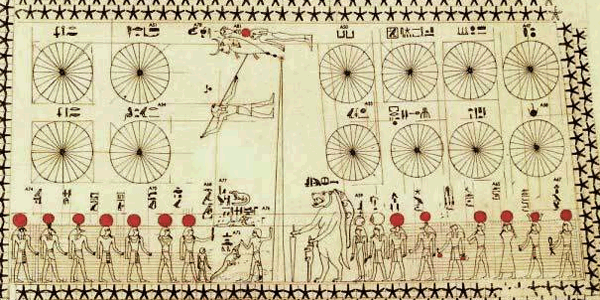 photo by NebMaatRa |
| c.1460 | SENENMUT, chief architect, astronomer, and former favorite of Hatshepsut, dies. Λ ASTRONOMY V: His tomb (TT353) ceiling contains a presentation of the northern constellations with celestial objects, Osiris as Orion, Isis as Sirius, Horus as Jupiter, Horus again as Saturn. A bird on the left represents Osiris as a phoenix linked with planet Venus as a morning star. Another figure of Horus spears an ox representing Set-Apep as the constellation Ursa Major. |
1500 SHT 1-122 1460 innov no date: aw |
| c.1460 | THUTMOSE-III (6th campaign) sails troops from Egypt to Byblos. Sails up Eleutheros River, takes Simyra, quells rebellion in Ardata. Marches on KADESH and besieges. | yr 30 BHoE 299, DMoN 86, wikT3 |
| c.1460 | KADESH destroyed by Thutmose-III. | yr 30 BHoE 195, DMoN 86, GEoP |
| c.1460 | Sons of defeated city rulers are deported to Egypt to Egyptianize them and to ensure cooperation of their fathers. | yr 30 BHoE 195, DMoN 86, GEoP |
| c.1459 | THUTMOSE-III (7th campaign) into Levant, takes port city of Ullaza and smaller Phoenician ports, takes more measures to prevent further rebellions. Takes excess Aramean grain which is stored in harbors. | yr 31 BHoE 301, GEoP, wikT3 |
| c.1457 | THUTMOSE-III (8th campaign) into Levant, sails directly to Byblos, makes boats which he book with him overland on what appeared to be another tour of Aram. Takes Katna and Senzar, goes north beyond where he had previously conquered, fights serious battle west of Halap, takes Halap, fights at Carchemish, crosses Euphrates into Mitanni, taking Mitannian king by surprise. Conquers Mitannian cities unopposed. Receives tribute from Hittites, Asshur, Babylon. Returns to Aram, takes Niy, where he hunts elephants. | 1457 MCAW 32 yr 33 B76 18-366, BHoE 302, DMoN 86, GEoP 194, Grim 216, Shaw 238, wikT3 |
| c.1457 | Λ GLASS V, used for ornament and vessels in northeast Mesopotamia from 1500, brought to Egypt, where glass making becomes improved on, especially at El Amarna. Objects, mostly beads, composed entirely of Glass paste appear. | 1500 OCD 467, wikAET 1450 MCAW 35 1400-1351 TTS no date: Shaw 239-40 |
| c.1456 | THUTMOSE-III (9th campaign) returns to Aram, suppresses rebellion at Djahy, raids Nuhasse area, takes Nuges. | yr 34 BHoE 313, GEoP, Grim 216, wikT3 |
| c.1456 | THUTMOSE-III campaigns in Λ PUNT, takes much tribute and a son of the chief of Irem hostage. | yr 33 nar yr 34 BHoE 313-4 |
| c.1455 | THUTMOSE-III (10th campaign). Quells rebellion in Aram, fights Mitanians around Halap, takes only ten prisoners, boasts of great victory, including tribute from Hittites. | yr 35 BHoE 314, GEoP, Grim 216, wikT3 |
| c.1454 | THUTMOSE-III (11th campaign). Records lost. | yr 36 GEoP, wikT3 no date: BHoE 315, Grim 216 |
| c.1453 | THUTMOSE-III (12th campaign) at Nuhashe. Records lost. | yr 37 GEoP, wikT3 no date: BHoE 315, Grim 216 |
| c.1452 | THUTMOSE-III (13th campaign) mainly in south Lebanon. Receives gifts from Cyprus and Assyrian province of Arrapakhitis. | yr 38 BHoE 315, GEoP, wikT3 |
| c.1451 | SHASU bedouin of south Levant and Sinai first mentioned in Egyptian texts. | 1450 BAR 34:06 Nov/Dec, 2008 |
| c.1451 | THUTMOSE-III (14th campaign) against the Shasu. | yr 39 BHoE 315, GEoP, wikT3 |
 pub dom |
| c.1450 | REKHMIRE, vizir of T-III, tomb TT100 at Thebes shows trade with many countries and duties of his office, including brick making shown above, and using the 40 scrolls of the law. Pictures illustrate melting of copper using foot operated leather BELLOWS (See China 450), followed by casting of doors for a temple. Arameans are shown bringing gifts of copper, ivory, live elephants and cats. Another picture illustrates braiding of leather rope. | 1460 MCAW 33 1450 SHT 1-453, 664 1440 SHT 1-627 |
| c.1450 | Oldest surviving CHARIOTS come from Egyptian tombs. | 15th cen SHT 1-727 |
| c.1450 | DYES for fabrics, including only indigo and safflower from 2000, now includes a full range of hues. | 1450 B76 5-1099 |
| c.1450 | CLEPSYDRA (water clock) V, used in Egypt: A bowl with a hole at the bottom, for water to leak either into, or out of. Oldest documentation is tomb inscription of Egyptian court official Amenemhet, which identifies him as its inventor. | 1500 crst 16th cen. wikWC 1450 TTS, TTT |
| c. 1450 |  Hearst Λ Medical V Papyrus 18 pages, 260 medical prescriptions written in hieratic. Topics range from "a tooth which falls out" to "remedy for treatment of the lung", but concentrates on treatments for problems dealing with urinary system, blood, hair, and bites by humans, pigs, and hippopotamuses. Also includes incantations and magic spells. 72% has no known curative elements.
Hearst Λ Medical V Papyrus 18 pages, 260 medical prescriptions written in hieratic. Topics range from "a tooth which falls out" to "remedy for treatment of the lung", but concentrates on treatments for problems dealing with urinary system, blood, hair, and bites by humans, pigs, and hippopotamuses. Also includes incantations and magic spells. 72% has no known curative elements.Doubts persist about its authenticity. |
photo: pub dom 2000 wikEMP time of T-III: wikHP |
| c.1448 | THUTMOSE-III (uprising campaign) into Levant, lands on Aramean coast, takes port of Arqata, quells rebellions in Arka plain, takes Tunip, takes Kadesh, destroys 3 surrounding Mitannian garrisons, returns to Egypt. | yr 42 BHoE 315, DMoN 87, GEoP, Grim 216, Shaw 238, wikT3 |
| c.1446 | THUTMOSE-III pharaoh 1504-1436, begins desecrating monuments and memory of HATSHEPSUT. | yr 46 or 47 Shaw 241 20 yrs after she vanished: DMoN |
| c.1445 | EXODUS - early date V | 1446 FHBC 202, ISBE 2-44 1445 bivu, HCC 1441 FLAP 60 |
| c.1440 | (Nubian campaign) NEHI, viceroy of Nubia for Thutmose-III, invades to 4th cataract. | yr 50 BHoE 318, DMoN 88, GEoP, Grim 215, wikT3 |
| c.1439 | THUTMOSE-III pharaoh 1504-1436, makes son AMENHOTEP co-king. | yr 51 BHoE 318, DMoN 88, Grim 217, Shaw 241 |
| c. 1436 | 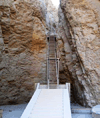 THUTMOSE-III dies. 5th pharaoh of 18th (Theban) Dyn from 1504. Unable to top Hatshepsut, he chooses to be entombed in an unimpressive hole in a wall, KV34, in Valley of the Kings, a trend followed by future pharaohs.
THUTMOSE-III dies. 5th pharaoh of 18th (Theban) Dyn from 1504. Unable to top Hatshepsut, he chooses to be entombed in an unimpressive hole in a wall, KV34, in Valley of the Kings, a trend followed by future pharaohs.Son, athlete & horseman, AMENHOTEP-II succeeds to 1425. |
photo: Hajor 1458 ae 1450 B76 6-472, 17-935, 18-367, CAH 2.1, Clay, DHJ 56, ISBE 2-41, JIAE, Murn, RAI3, SHWC 20, SOTS 44, WERE, bk, lveg, pic, resh, scar, tig, treg 1448 Sdl 1-27, 164 1447 BHoE 1439 IDB 2-49 1436 CWH, FLAP 92, GEoP, MCAW 32, MRDK 288, RAI2 1425 CVK, Grim, Shaw, ktut, phou, nga, wikP, wikT3 1424 DMoN |
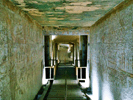 Hajor |
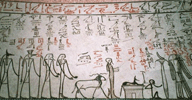 Hajor |
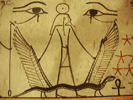 Hajor |
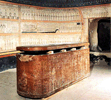 pub dom |
| c.1436 | Book of Amduat "That Which Is In the Afterworld" A 12 step obstacle course wherein a dead pharaoh navigates thru the underworld, by sailing his solar boat or walking to the afterlife. 1st complete version used in tomb of Thutmose-III. Originally it was reserved for pharaohs, though his vizir Useramun also has a copy in his tomb. Complete versions will also be used by Amenhoteps II & III, partial versions by Tuthmose-IV, Seti I, Tutankhamon, Merneptah, Rameses-III thru VI, excerpts by Rameses-IV & IX. No use of it made by Akhenaten or Horemheb and Rameses-I, who prefer the Book of Gates . |
1425
wikT3 no date: sftp |
| c.1436 | ARAM: Cities of Orontes Valley led by Kadesh & Tunip, rebel against AMENHOTEP-II. | 1450 B76 17-935 at death of T-3: BHoE 323 |
| c.1435 | AMENHOTEP-II, pharaoh 1436-25, continues his father's desecration of the monuments of HATSHEPSUT. | no date: Shaw 241 |
| c.1435 | AMENHOTEP-II, pharaoh 1436-25, 1st campaign, crushes Aramean rebellion. Personally executes 7 leaders at Kadesh, brings back bodies of enemies tied head downward on the prow of his ship to diplay at Thebes. All but 1 are mounted on the city walls. The last is taken to Nubia and hung on the wall of Napata. | 1488 B76 17-935 yr 2 BHoE 324 yr 3 Grim 218, wikA2 yr 7 B76 6-473, Shaw 244 no date: GEoP 199-200 |
| c.1435 | AMENHOTEP-II, pharaoh of 18th (Theban) Dyn 1436-25, on returning to Thebes, dispatches an expedition to Nubia. | yr 2 BHoE 325 |
| c.1433 | Amada Stele describes Amenhotep-II's Aramean campaign. Lists among captives, 3,600 Hapiru, 15,200 Shasu, 36,300 Hurrians, 15,070 men of Nuhashe. |
Amen-II yr 3 GEoP 200 1430 AYGC 87 |
| c.1432 | Limestone quarries at TURA east of Nile south of Heliopolis reopened by Amenhotep-II. | yr 4 Shaw 243 |
| c.1429 | AMENHOTEP-II, 6th Pharaoh of 18th Dyn. 1436-06, has to reconquer many Aramean cities conquered in 1435, takes 89,600 prisoners. | 1443 B76 17-935 yr 7 wikA2 |
| c.1427 | AMENHOTEP-II reconquers some cities in Canaan, campaigns as far north as the Sea of Galilee, brings 70,000 captives back to Egypt, then settles into peaceful reign. After this campaign Egypt and Mitanni never fight again. Caanan under Egypt until 1350. | 1441 B76 17-935 1430 MCAW 32 Amen-II yr 9 B76 6-473, GEoP 202, Shaw 244, wikA2 |
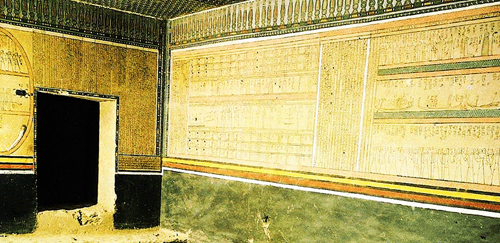 |
photo by Ignati |
| c.1425 | Son of Thutmose-III, AMENHOTEP-II dies age 26-35. 6th Pharaoh of 18th Dyn from 1436. Tomb KV35 in Valley of the Kings contains complete texts of the Book of Amduat. Son, THUTMOSE-IV succeeds until 1390. | 1425 CAH 2.1, ISBE 2-41, JIAE, RAI3, WERE, bk, ktut, wikP 1423 lveg 1422 Sdl 1-28, 164 1420 BHoE 1419 Clay, Murn, pic, scar, tig 1413 GEoP 1412 MRDK, resh 1401 CVK, Grim, ae
1401 or 1397 wikA2 1400 Shaw, phou 1398 DMoN 1392 treg 1388 nar |
| c.1425 | KENAMUN, chief steward of Amenhotep-II, dies. Tomb TT93 in the Valley of the Nobles at Thebes. | 1450-01 no date: crbs |
| c.1425 | PARCHMENT used for writing in Egypt. | 1450-01 TTS |
| c.1420 | 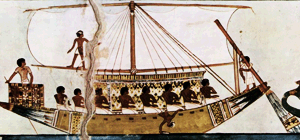 RIVERBOAT portrayed in tomb of Menna, probably during reign of Thutmose-IV.
RIVERBOAT portrayed in tomb of Menna, probably during reign of Thutmose-IV. |
photo pub dom 1422-11 wikAET |
| c.1420 | Pictures of POPPIES V appear in Egypt. | 1550-1292 wikP |
| c.1418 | 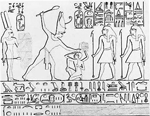 Stele at Konosso near Aswan erected by THUTMOSE-IV, here shown smiting enemies before Nubian gods Dedwen and Ha. Queen Iaret stands behind T-IV. Stele at Konosso near Aswan erected by THUTMOSE-IV, here shown smiting enemies before Nubian gods Dedwen and Ha. Queen Iaret stands behind T-IV. |
photo pub dom yr 7 wikIrt |
| c.1417 | Rebellion in NUBIA suppressed by THUTMOSE-IV. | yr 8 BHoE 328, Grim 219, nar |
| c.1413 | 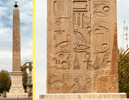 OBELISK (the tallest yet, 105 feet), designed and begun under Thutmose-III, is completed and erected by Thutmose-IV at Karnak Thebes. OBELISK (the tallest yet, 105 feet), designed and begun under Thutmose-III, is completed and erected by Thutmose-IV at Karnak Thebes.Now in Rome, known as the "Lateran obelisk" . |
photo Matthias Kabel 1413 MCAW 35 1401-1391 dlib |
| c.1405 | THUTMOSE-IV asks ARTATAMA-I, king of Mitanni 1410-00, for a daughter to marry. Artatama hesitates then complies. | no date: BHoE 328 |
| c.1400 | 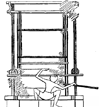 Λ LOOM: Vertical framed loom with two beams is used for large pieces of cloth.
Λ LOOM: Vertical framed loom with two beams is used for large pieces of cloth. |
art: pub dom 1425 gtbrg 1400 SHT 1-427 |
| c.1400 | Λ INCENSE V: Earliest remains found in 18th Dynasty tombs. | 1400 SHT 1-294 |
| c.1400 | PORCELLAIN ornaments begin. | 1400 EOET 100 |
| c.1400 | WINDLASS used in Egypt. A windlass is a winch. | 1400 TTT |
| c.1400 | AXLE GREASE made by Egyptians from fat, lime, & other stuff. | 1400 B76 13-523 |
| c.1400 |  Earliest surviving detailed GARDEN PLAN put in a tomb at Beni Hassan near Thebes. Earliest surviving detailed GARDEN PLAN put in a tomb at Beni Hassan near Thebes. |
photo {{PD-US}} 2300 wikGBHE 1400 B76 7-891 |
| c.1391 | PERISTYLE HALL built by Thutmose-IV at Karnak. Lasts until destroyed by Amenhotep-III. |  |
hhoto Kairoinfo4u 1401-1391 dlib |
| Peristyle means a row of columns surrounding a space within a building. |
| c.1390 | THUTMOSE-IV dies. Son of Amenhotep-II, 7th pharaoh of 18th Dyn from 1425. Entombed in Valley of the Kings KV43, but his body will be moved to the mummy cache in KV35. Son AMENHOTEP-III succeeds until 1352. Capital, at Thebes from 1674, moved to Memphis until 1358. |
1417 B76 6-473, CAH 2.1, JIAE, RAI3, bk 1416 ISBE 2-41 1413 Sdl 2-122 1412 WERE 1411 BHoE, RAH 74 1410 lveg 1406 GEoP 1402 resh 1391 CVK, ae 1390 Grim, Shaw, phou, wikP 1389 ktut 1388 DMoN 1386 Clay, Murn, pic, scar, tig, treg 1380 nar |
| c.1389 | AMENHOTEP-III marries queen Tiy, dau of chariotry officer Yuya. | by yr 2 DMoN 89, Shaw 253 |
| c.1385 | Rebellion in NUBIA suppressed by MERMOSE, viceroy of Amenhotep-III. Mermose penetrates beyond 4th cataract, possibly 5th. | 1406 MCAW 32 yr 4 BHoE 330 yr 5 B76 6-473, DMoN 89, GEoP 205, Grim 222, Shaw 260 |
| c.1380 | CLEPSYDRA (water clock) V, used from at least 1450: earliest surviving example used in Temple of Amen-Ra at Karnak in reign of Amenhotep-III. (See Greek 325) | 1450 TTS, TTT 1400 B76 4-743 1417-1379 wikWC reign of Amen-3: Grim 206 |
| c.1380 | CANAL from Nile to Red Sea built by Amenhotep-III. | 1380 TTPC 7 1250-01 TTS |
| c.1380 | AMENHOTEP-III builds palaces and a lake for his wife, Tiy. On the lake is a barge named "The Aton Gleams". | 1390/70 MCAW 37 |
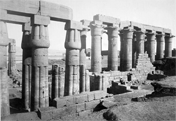 {{PD-US}} |
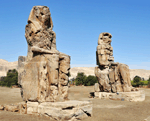 Marc Ryckaert |
| c.1380 | AMENHOTEP-III builds a mortuary temple on the west bank of the Nile, opposite Thebes, though he will not be buried in it. It is guarded by 2 seated "Colossi of Memnon". | 1390-70 MCAW 37 1375-58 alpst 1350 123rf, shst |
| c.1380 | AMENHOTEP-III pharaoh 1390-52, marries GILUKHIPA, dau of SHUTTARNA-II, king of Mitanni 1400-1385. 317 Mitanian women accompany her to Egypt. | yr 10 B76 6-473, BHoE 333 yr 11 Grim 223 |
| c.1370 | Theban prosperity peaks in reign of Amenhotep-III 1390-52. | 1400 B76 18-261 |
| c.1370 | AMENHOTEP-III pharaoh 1390-52, receives TADUKHEPA, dau of TUSHRATTA, king of Mitanni 1380-50, as a wife for his son AMENHOTEP(IV). | no date: BHoE 333 |
| c.1370 | RATTLES, made of gourds, used by priests from ?, now used to amuse children. | 1360 EOET 373 |
| c.1358 | Amenhotep-III, residing at Memphis from 1390, moves back to THEBES. Capital at Thebes until 1346. | yr 30 DMoN 91-94 |
| c. 1352 | AMENHOTEP-III dies age 40-50. 8th pharaoh of 18th Dyn from 1390. Entombed in the West Valley of the Kings WV22, which has 2 subsidiary chambers for his wives Tiye and Sitamen (also his dau). His mummy will be moved to KV35 during the reign of Smendes. Son age 12 AMENHOTEP-IV succeeds until 1334, but changes name in 1347. |
1380 bk 1379 B76 6-473, CAH 2.1, ISBE 2-41, JIAE, RAI3 1377 Sdl 1-28 1375 BHoE, RAH 74, WERE 1372 lveg 1367 GEoP, MCAW 36 1364 resh 1353 CVK, ae 1352 Grim, Shaw, phou, wikP 1351 ktut 1349 Clay, Murn, pic, scar, tig 1348 DMoN 1344 treg 1339 nar |
| c.1350 | Balance Λ SCALE, used in Egypt for precious metals from 2500 at latest, only now begins to be used for ordinary commerce in Egypt. A small wooden balance is used in El-Amarna, and a larger jeweler's balance is depicted in a Theban tomb. | 1450-01 TTS 1350 SHT 1-779-84 |
| c.1350 |  MUSIC: Flute players portrayed in a tomb. MUSIC: Flute players portrayed in a tomb.(See musician 1000) |
drawing pub dom 1350 wikMI |
| c.1350 |
|
yr 2 of reign: Grim 233 |
| c.1348 | AMENHOTEP-IV begins new temple of Aten at Thebes. | yr 3 nar |
| c.1347 | MAYA, High Priest of Amun at Thebes dismissed by Amenhotep-IV. | yr 4 nar |
| c.1347 | AMENHOTEP-IV, 9th pharaoh of 18th Dyn 1352-34, goes publicly monotheist, changes name to AKHENATEN. Begins new capital at AKHETATEN (later called El-Amarna) half way between Memphis and Thebes. | 1374 TTPC yr 4 B76 6-473, MCAW 36, nar yr 5 DMoN 98, Grim 227 yr 6 Clay 122, WERE 206 |
| c.1347 |  Chief god of Egypt, anthropomorphic Amun-Ra from 1550, trashed in favor of abstract ATEN. The sun theme continues from Ra thru Amun-Ra to its fullest expression in Aten. Aten, 1st mentioned in Story of Sinuhe , is creator, giver of life, and nurturing spirit of the world. Aten is asexual, has no Creation Myth or family, but is mentioned in the Λ Book of the Dead V. His full title is "Ra-Horakhty who rejoices in the horizon" shortened to Ra-Horus-Aten or just Aten.
Chief god of Egypt, anthropomorphic Amun-Ra from 1550, trashed in favor of abstract ATEN. The sun theme continues from Ra thru Amun-Ra to its fullest expression in Aten. Aten, 1st mentioned in Story of Sinuhe , is creator, giver of life, and nurturing spirit of the world. Aten is asexual, has no Creation Myth or family, but is mentioned in the Λ Book of the Dead V. His full title is "Ra-Horakhty who rejoices in the horizon" shortened to Ra-Horus-Aten or just Aten. |
Amun: Jeff Dahl Aten: AtonX yr 2 Grim 227 no date: wikAtn |
| c.1347 | MONOTHEISM? Probably not. Akhenaten replaces chief god Amun with Aten as head of a HENOTHEISTIC system, while the people worship the god/pharaoh. | no date: SHWC 25 |
| c.1346 | AKHETATEN (later called El-Amarna) half way between Memphis and Thebes, completed. | yr 6 DMoN 99 |
| c.1346 | Capital of Egypt: THEBES from 1358, moved to Akhetaten (El Amarna) until 1331. This is the AMARNA PERIOD. | 1349 aic yr 5 nar yr 6 DMoN 99, WERE 207 |
| c.1345 | Horseback riding evidenced in Egypt. | 1345 B76 8-1092 |
| c.1344 | TIY, dau of Yuya & Tuya, widow of Amenhotep-III, mother of Amenhotep-IV, dies. | Akhen yr 8 Grim 222 |
| c.1340 | MEKETATEN, 2nd dau of Akhenaten & Nefertiti, dies. | Akhen yr 12 Grim 234 |
| c.1340 | NEFERTITI, wife of Akhenaten, put away in disgrace. Meriaten replaces her beside Akhenaten in ceremonies. | Akhen yr 12 MCAW 36 |
| This theory has been discredited, since erasures of monuments belonging to a queen of Akhenaten have been shown to refer to Kiya instead. | wikN |
| c.1340 | Rebellion in NUBIA quelled by Akhenaten. | yr 12 Shaw 270 |
| c.1340 | AKHENATEN receives tribute from all subserviant countries in a big ceremony. | yr 12 Shaw 270 |
| c.1340 c.1340 c.1340 c.1340 |
Amarna Letters , About 380 tablets all on clay, mostly written in Akkadian, but contain some Canaanite glosses in cuneiform. include following letters: Amenhotep-III to & from Babylon king Kadashman-Enlil Babylon king Burna-Buriash-II to Amenhotep-III & IV Amenhotep-IV to Babylon king Burna-Buriash-II Assyria king Ashur-Uballit-I to Amenhotep-IV Mitanni king Tushratta to Amenhotep-III & IV Mitanni king to Palestine kings Amenhotep-III to & from Arzawa king Tarhundaraba Ugarit king Niqm-Adda-II to pharaoh Nuhasse king Addunirari to pharaoh Qatna king Akizzi to Amenhotep-III Amurru king Abdi-Asirta to pharaoh Gubal king Rib-Addi to Pharaohs & Egypt officials Beruta king Ammunira to pharaoh Sidon king Zimriddi to pharaoh Tyre king AbiMilki to pharaoh Amurru king Aziri to pharaoh Mittani king Shuttarna to pharaoh Damascus mayor Biryawaza to king Acco king Zatatna to pharaoh Megiddo king Biridija to pharaoh Some mention Shardana and Danuna Sea Peoples, and Anatolian Lukka. |
1500 SHT 1-582 1386-13 pczy 1377-60 BBP 27 1350s-30s wikAL 1340 hifi |
| c.1340 | WOOD WORKING abundant at El-Amarna: painted wood columns, ceiling beams, bonding for walls, supports for stairs, inlay work. | 1350 SHT 1-306 |
| c. 1340 | Book of the Heavenly Cow written in Middle Egyptian to explain death and suffering: Humans plot against Ra, who sends Hathor to slaughter the rebels, bringing death into the world. Ra saves the rest of humanity by putting out beer dyed to resemble blood, which Hathor drinks, becoming drunk. Ra withdraws into the sky and resides on the back of Nut the heavenly cow. He organizes the underworld for the dead to dwell in.
Human suffering is caused by separation from Ra. 1st copies of it appear in tombs of Seti-I (KV17), Rameses-II (KV7) and Rameses-III (KV11). In each instance, it is in an annex off the burial chamber. |
Amarna Period: wikBHC |
| c.1338 | NEFERTITI, dau of Ay, wife of Akhenaten, drops out of history. But in the Theban tomb of Parennefer TT188, Amenhotep-IV and Nefertiti are portrayed seated on a throne. Her mummy has never been identified. | 1330 wikN Akhen yr 14 Grim 234 |
| c.1336 | AKHENATEN, 9th pharaoh of 18th Dyn 1352-34, makes son or bro SMENKHKARE co-king. | 1370 WERE 1364 JIAE 1351 MRDK 1350 GEoP 1338 Grim, Shaw, phou 1336 Clay, Murn, ktut, pic, scar, treg 1335 ae, tig |
| c. 1334 | AKHENATEN, formerly Amenhotep-IV, dies in unknown circumstances. Son of A-III, 9th pharaoh of 18th Dyn from 1352. Buried at Akhetaten. His body will be removed after the court returns to Thebes. DNA proves a body found in tomb KV55 to be father of Tutankhamun, and is therefore probably Akhenaten. Co-king SMENKHKARE sole rule 1334. | 1366 WERE 1363 bk 1362 B76 6-474, CAH 2.1, JIAE, RAI3 1358 RAH 81, Sdl 1-28 1355 lveg 1350 GEoP, MCAW 1347 MRDK 1343 DMoN 1338 Grim 1337 ktut 1336 Shaw, phou 1335 ae 1334 Clay, Murn, pic, resh, scar, tig, treg, wikP 1322 nar |
| c. 1334 | SMENKHKARE dies age 20. Son or bro of Akhenaten, 10th pharaoh of 18th Dyn from 1334. Buried at Akhetaten. Probable mummy found in KV55. Son of Akhenaten & Kiya, TUTANKHATEN succeeds (age 9) until 1325. | 1366 WERE 1362 JIAE 1361 B76 6-474, CAH 2.1 1348 MRDK 1347 GEoP 1343 DMoN 1336 Grim, Shaw, phou 1334 Clay, Murn, ae, ktut, pic, scar, treg, wikS 1333 CVK, tig, wikP |
| Neferneferuaten succeeds until 1332. | wikN |
| c.1332 | TUTANKHATEN, 11th pharaoh of 18th Dyn 1334-25, changes name to TUTANKHAMUN. | yr 2 of reign: Clay 129 yr 3 of reign: wikTt |
| c.1331 | CAPITAL of Egypt: at AKHETATEN from 1346, moved back to THEBES until 1279, by Tutankhamun. | 1336 aic, wikNKE yr 1 Grim 237 yr 3 MCAW 36 |
 Peter Bubenik |
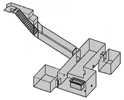 Roger469 |
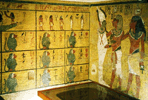 Hajor |
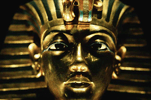 Steve Evans |
| c.1325 | TUTANKHAMUN dies age 17 or 18. Son of Akhenaten & Kiya, 11th pharaoh of 18th Dyn from 1334. Buried in Valley of the Kings KV62, where his tomb will remain undisturbed until 1922. Vizir (age c.70) AY succeeds until 1321. | 1357 WERE 1352 B76 6-475, JIAE, RAI3, bk 1349 Sdl 2-122 1339 GEoP, MCAW 1337 MRDK 1333 DMoN 1327 Grim, Shaw, phou 1325 CAH 2.1, Clay, Murn, ae, ktut, pic, resh, scar, tig, treg 1324 wikP 1323 CVK 1311 nar |
| c.1325 | Tomb of Tutankhamun contains skin cream, lip color, cheek rough, and Λ PERFUME still usable when opened in 1922. | 1400 TTT 1350 EOET 221 |
| c.1325 | COMOSITE BOWS buried in tomb of Tutankhamun. (See Megiddo 1468, crossbow 1300) |
1324 wikCB |
| c.1325 | ANKES-NAMUN, widow of Tutankhamun, sends 2 letters to Suppiluliuma-I, king of Hittites 1375-22, asking him to send a son to be her husband and pharaoh. Suppiluliuma complies, but his son is killed in Aram by order of Horemheb. | 1339 MCAW 38 1333 DMoN 113 |
| c.1325 |
|
1629/8 wikLMP 1325 aemed, brtms 1300 abmk, crst |
| c.1324 | Royal tombs at Akhetaten are stripped, bodies taken to Thebes for reburial. Body of Akhenaten never positively identified. | soon after Tut dies: DMoN 107 |
| c.1323 | AY nominates army officer Nakhtmin, possibly Ay's son or adopted son, to succeed him rather than Horemheb. | no date: wikH |
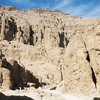 Roland Unger |
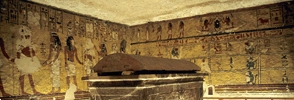 Roland Unger |
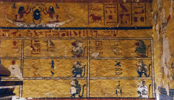 kairoinfo4u |
| c. 1321 | AY dies. 12th pharaoh of 18th Dyn from 1325. Though he has an unfinished tomb at Amarna, he is buried in Valley of the Kings tomb WV23. Only the burial chamber is decorated. General HOREMHEB succeeds until 1293. He removes Naktmin's rival claim to the throne, smashes Ay's sarcophagus, chiseles out Ay's name and figure from his tomb walls and probably destroys Ay's mummy. |
1353 WERE 1352 JIAE, RAI3 1348 B76 6-475, CAH 2.1, GEoP, bk 1345 Sdl 1-29 1342 lveg 1333 MRDK 1328 DMoN 1323 Grim, Shaw, phou 1321 Clay, Murn, ae, ktut, pic, resh, scar, tig, treg 1320 wikP 1319 CVK 1307 nar |
| c.1320 | Tomb (TT49) of NEFERHOTEP (not to be confused with 1750) chief clerk of Amun on west bank of Nile, opposite Thebes. In courtyard 2 stela flank the entrance. Entrance leads into a hall which connects via a doorway to a hall containing 4 pillars. At the back of the pillared hall a niche contains seated statues of Neferhotep and wife Iuy. | 1327-3 mtms
1320 lsgrd r. of Ay and/or Horem: gptlgy, wikLTT, wikTT49 |
| c.1320 | HOREMHEB usurps and enlarges Ay's mortuary temple at Medinet Habu for his own use and erases Ay's titulary on the back of a 17 foot statue by carving his own titulary in its place. | no date: wikH |
| c.1320 | HYPOSTYLE HALL begun at Karnak (northeast of Thebes) by Horemheb. He builds the 2nd, 9th and 10th Pylons, using recycled talatat blocks from Akhenaten's monuments. Not finished until 1278. | 1320 MCAW 39 |
| Hypostyle means flat roof supported by columns. |
| c.1313 | Tomb of Thutmose-IV, recently robbed, is restored by Horemheb. | Horem yr 8 DMoN 117, wikH |
| c.1300 | SPOKES of chariots (4 from 2000) increased to 6. (See Anatolia 1400, China 1300) |
1313 CWH |
| c.1300 | Tomb art changes from pleasant scenes of everyday life to the perils of the afterlife. | 1300 MCAW 41 |
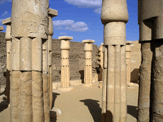 Neithsabes |
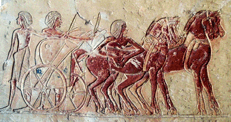 Neithsabes |
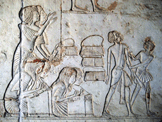 Neithsabes |
| c.1300 | TOMB at SAQQARA near Memphis, begun for Horemheb when he was a general during reign of Tutankhamun, partly with cannibalized blocks from Old Kingdom monuments, is finished, but he will not be buried in it. It will be used for his wife Mutnedjemet and a baby. | no date: ae, wikH |
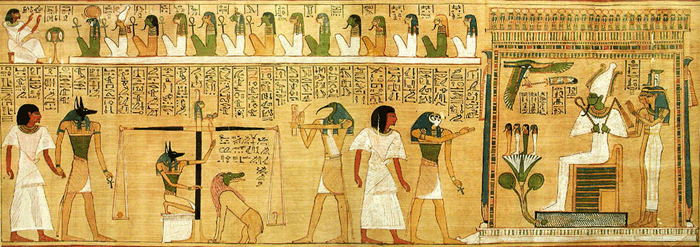 photo by Jon Bodsworth |
| c.1300 | HUNEFER, scribe during 19th Dyn, writes a Λ Book of the Dead V. In the 3 scenes, the dead man (Hunefer) is taken to the judgment hall by jackal-headed Anubis. His heart is weighed, with Ammut awaiting the result and Thoth recording. Having passed the test, Hunefer is presented by falcon-headed Horus to Osiris, seated in his shrine with Isis and Nephthys. |
1300 wikH |
| c.1300 | Iron smelting first evidenced in Egypt, but is not wide spread. | 1300 B76 12-246 |
 photo Jean-Pierre Dalbéra |
| c.1293 | HOREMHEB dies. (parents unknown) 13th pharaoh of 18th Dyn from 1321, appoints vizir Paramesu successor and dies w/o heir. Buried in Valley of the Kings tomb KV57. Paramesu (age c.50) succeeds as RAMSES-I until 1291. |
1320 B76 VIII-410, 6-475, CAH 2.1, JIAE, RAI3, bk 1319 WERE 1318 Sdl 1-29 1315 BHoE 1314 lveg 1308 GEoP 1307 CVK, ae 1306 Jud 13-1545 1305 MRDK 1301 AYGC 159 1298 DMoN 1295 Grim, Shaw, phou, treg 1293 Clay, Murn, pic, resh, scar, tig 1292 ktut, nar, wikH, wikP |
| c.1293 | 18th DYNASTY ends. At Thebes from 1550. | 1345 Sdl 2-80 1342 lveg 1320 CAH 2.1, JIAE, RAI3 1319 CVK 1307 ae 1305 MRDK 1295 FHBC 225, Shaw, phou, treg 1293 Clay, pic, resh, tig 1292 ktut, nar, wikP |
| 19th DYNASTY begins until 1186. |
| c. 1293 | Book of Gates (an abridged Book of Amduat ) first appears in tomb KV57 of Hoermheb. Describes the 12 hour nocturnal journey of the sun (Ra) thru the underworld. Each of 12 gates is guarded by a goddess who must be appeased in order to pass. The goddesses each have different titles, and wear different colored clothes, but are otherwise identical, each with a 5 pointed star above her head. The main innovation, is a judgment scene before Osiris, after the 5th gate to ensure punishment of the enemies of Ma'at. The longest complete versions are on sarcophaguses of Seti-I, and probably Ramses-II, and in the temple of Osiris at Abydos (a version dating back to Merenptah). The Book has 2 distinct sources: the long version - external to the Valley of the Kings. The short version, begins under Horemheb. The 2 versions combine under Merenptah, 1st king to use in his tomb the elements of the last part of the Book. | no date: osrs, wikBG |
| c.1291 | RAMSES-I makes son SETI co-king. | yr 2 BHoE 408 |
| Tomb KV16 of Ramses-I portrays Ra traveling thru the underworld in his barque, from the Book of Gates. |
 {{PD-US}} |
| c.1291 | RAMSES-I dies. Son of a general named Seti, 1st pharaoh of 19th Dyn from 1293. Buried in a quickly built tomb KV16 in Valley of the Kings. Son SETI-I succeeds until 1279. | 1318 B76 VIII-410, 6-475, CAH 2.2, JIAE, WERE 1317 RAI3, Sdl 1-164 1313 BHoE, lveg 1308 GEoP 1306 CVK, ae 1305 Jud 13-1545 1303 Jud 14-1192 1285 DMoN 1294 Grim, Shaw, phou, treg 1291 Clay, Murn, nar, pic, resh, scar, tig 1290 ktut, wikP |
| c. 1290 | SETI-I marches northeast from the city of Tjaru in north-east Delta along the "Horus Military road" containing a series of army forts, along the Mediterranean coast. While crossing Sinai, he fights the Shasu bedouin. In Aram, he takes Acco and Tyre, receives tribute from some city states. Others, including Beth-Shan and Yenoam, have to be captured but are easily defeated. The attack on Yenoam is illustrated in his war scenes, while other battles, such as the defeat of Beth-Shan, are not shown because the king did not personally participate. He confronts Hittites at KADESH, but does not seek battle, captures Amurru and Kinza, forces BENTISHINA, king of Amurru, vassal of Hittites, to switch loyalty until 1284. He receives submission of the chiefs of Lebanon, who are compelled to cut down cedar as tribute. | 1308 MCAW 38 1300 MCAW 40 yr 1 BHoE 410, DMoN 120, Grim 247, wikS1 early in reign of Muwatalli-II: hinf |
| c.1288 | SETI-I probably conducts operations against Libyans who had invaded the western Delta. | yr 2 BHoE 412 |
| c.1286 | SETI-I 2nd pharaoh of 19th Dyn 1291-79, campaigns in Levant, storms KADESH, probably takes it, marches north, fights Hittites in Orontes valley (1st battle between a pharaoh and Hittites). Outcome unknown. Returns to Thebes. | no date: BHoE 412 |
| c.1285 | Balance of power between Hittites and Egyptians is restored in Levant. KADESH remains under Hittites. Coastland south of Litany River under Egypt. | Seti-I yr 6 DMON 121 no date: BHoE 413 |
| c.1283 | Rebellion in NUBIA at Irem. Seti-I sends troops, which crush it after a 7 day campaign and take over 600 prisoners. | yr 8 DMON 121, nar, wikS1 |
| c.1282 | SETI-I, 2nd pharaoh of 19th Dyn 1291-79, turns attention to gold mines of Nubia. Improves roads to Nubia. | yr 9 Shaw 287 |
| c.1282 | SETI-I personally opens new rock quarries at Aswan to build obelisks and colossal statues, most of which are only partly finished or decorated by the time of his death. | yr 9 wikS1 |
| c.1282 | SETI-I appoints son Ramses his chosen successor, but a coregency is unlikely. | yr 9 wikS1 |
| c.1280 | Λ EXODUS - late date Based on the assumption that the intervening period until Solomon is far shorter than the 480 years of 1K 6:1. | 1290 AYGC 159, FLAP 60, IDB 1-584, ISBE 2-44, 1275 TTPC 1250 FHBC 203 1235 MCAW 40 |
 {{PD-US}} |
| c.1279 | Son of Ramses-I, SETI-I dies unexpectedly in late 30s. 2nd pharaoh of 19th Dyn from 1294. Buried in Valley of the Kings tomb KV17, deepest of all New Kingdom royal tombs: 136m. In a scene from the Book of Gates, Horus escourts 4 reps of each of the 4 races (Egyptians, Semites, Nubians, Libyans) into the underworld. Son RAMSES-II succeeds until 1213. |
1304 B76 6-475, CAH 2.2, JIAE, RAI3, SOTS 45, bk 1301 Sdl 1-29, 164, lveg 1299 WERE 1292 BHoE, RAH 82, SHWC 29 1291 GEoP 1290 CVK, Jud 13-1545, 14-1192, MCAW 40, ae 1289 MRDK 1279 DMoN, Grim, Shaw, ktut, nar, phou, pic, treg, wikP, wikS1 1278 Clay, Murn, resh, scar, tig |
| c.1279 | CAPITAL of Egypt: THEBES from 1331, , moved to PI-RAMESES until 1213. | 1279 wikNKE |
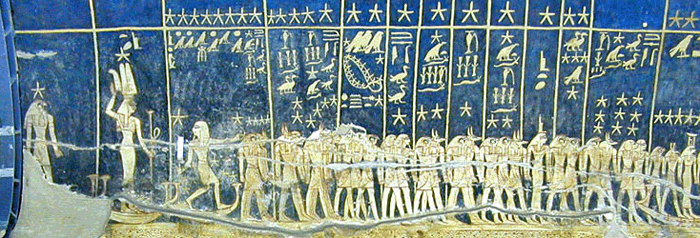 photo Jean-Pierre Dalbéra |
| c.1279 | Λ ASTRONOMY V: Ceiling of tomb of Seti-I contains a presentation of the northern constellations, with same figures as those of Senenmut 1460, but in different positions. | no date: innov |
| c.1279 | 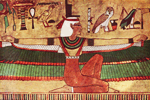 ISIS portrayed with outstretched wings in tomb of Seti-I. |
1360 Photo pub dom |
| c.1278 | RAMSES-II, pharaoh of 19th Dyn, 1279-13, calls himself "beloved of Set", cannibalizes monuments of Middle Kingdom to build his own monuments more than any other pharaoh of 19th Dyn. | no date: BHoE 195, NLEM 20 |
 photo by Roland Unger |
| c.1278 | White marble TEMPLE at ABYDOS, begun by Seti-I, finished by Ramses-II. | yr 1 wikS1 |
|
| c.1278 | HYPOSTYLE HALL at Karnak (northeast of Thebes), begun 1320 by Horemheb, finished by RAMSES-II. | no date: MCAW 39 |
| c.1278 | RAMSES-II, pharaoh of 19th Dyn, 1279-13, begins building PI-RAMSES - using Hebrew slaves according to Exodus 1:11. | no date: MCAW 40 |
| c.1277 | SHERDEN Sea People attack Nile Delta, and are defeated by Ramses-II in a sea battle. | 1278 hifi yr 2 Grim 250, wikSP |
| Recorded on Tanis Stele II "the unruly Sherden (Sardinians?) whom no one had ever known how to combat, they came boldly sailing in their warships from the midst of the sea, none being able to withstand them." Some Sherden are taken prisoner, and then join his army. |
| c.1277 | RAMSES-II, pharaoh of 19th Dyn, 1279-13, begins wars with Nubians and Libyans. | yr 2 wikSP |
| c.1275 | RAMSES-II, pharaoh of 19th Dyn, 1279-13, invades Canaan until ?, to fight Hittites (and possibly Sea People). | yr 4 BHoE 424, Brit Ramses-II, DMoN 124, Grim 253, nar yr 5 IDB 4-11 |
| c.1275 | RAMSES-II, returns to Egypt until 1274. | yr 4 Grim 253 |
| c.1274 | RAMSES-II, pharaoh of 19th Dyn, 1279-13, marches thru Canaan and Galilee, caught unprepared by strong chariot force of Hittites & allies near KADESH. In great danger. Keeps enemies at bay until reinforcements arrive from Amurru and elsewhere, and then dispurses enemies. | 1300 WPOT 205 1299 WPOT 92 yr 5 DMoN 126, Grim 253, IDB 2-51, 4-11 |
| c.1274 | BATTLE of KADESH: Draw battle, but Hittite political victory. Ramses-II fails to take Kadesh, and withdraws. Hittites retain Aram. | 1300 B76 17-936, WPOT 205 1299 WPOT 92 1298 LEWH 50 1296 Sdl 1-29, 97 1288 RAH 84 1287 IDB 3-802 1286 SOTS 91 1285 MCAW 40, CWH, RAI2 1274 nar yr 5 IDB 2-51 |
| c.1273 | Ramses-II and his army return to Egypt. | yr 6 DMoN 126 |
| c.1272 | RAMSES-II, pharaoh of 19th Dyn, 1279-13, returns to Canaan. Half of his troops are under his son Amon-hir-hepeshef, which chases the Shosu tribes across the Negev to the Dead Sea, capture Edom-Seir, then capture Moab. Ramses attacks Jerusalem and Jericho, then enters Moab and joins his son. | yr 7 DMoN 127, Grim 256, hinf |
| c.1272 | RAMSES-II and son Amon-hir-hepeshef, march to Hesbon, Damascus, take Kumidi, then recapture Apa district. | yr 7 Grim 256, hinf |
| c.1272 | LAW: EQUALITY of WOMEN before the law is shown by land-ownership litigation described on a scribe's tomb. | 1272 MCAW 41 |
| c.1271 | Egyptian army sent into Canaan and Syria until 1270. Occupies Acco, moves north to Dapur and erects a statue of Ramses-II, reaches Tunip, where no Egyptian had been for 120 years, recovers Kadesh and northern Amurru. | yr 8 Grim 256 |
| c.1270 | APPLES cultivated along the Nile by Ramses-II. | 1300 grddst |
| c.1265 | 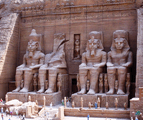 TEMPLE of ABU-SIMBEL on upper Nile begun 20 years previously, dedicated to gods Amun, Ra-Horakhty, Ptah, and a deified Ramses-II, finished. 35m wide with four 20m tall statues of R-II sculptured directly from the rock, topped by a frieze with 22 baboons. TEMPLE of ABU-SIMBEL on upper Nile begun 20 years previously, dedicated to gods Amun, Ra-Horakhty, Ptah, and a deified Ramses-II, finished. 35m wide with four 20m tall statues of R-II sculptured directly from the rock, topped by a frieze with 22 baboons. |
photo Fred Hsu 1265 wikAS 1260 TTT |
| c.1261 | MURSILI-III, former king of Hittites 1272-67, takes refuge in Egypt. Ramses-II refuses extradition demands of Hattusili-III. | Ram-II yr 18 Grim 257 |
| c.1261 | Egyptian army sent into Edom and Moab, suppresses local rebellions, returns via Canaan. | Ram-II yr 18 Grim 257 |
| c.1259 | Hittite peace envoy meets Ramses-II at Pirameses. | Ram-II yr 20 Grim 261 |
| c.1259 | The IREM of Upper Egypt rebel and are crushed by Ramses-II. 7,000 prisoners taken. | Ram-II yr 20 Grim 259 |
| c.1259 | SETAU, Ramses' viceroy of Kush, invades land of Jam in Kush. | Ram-II yr 21 nar |
| c.1258 | Treaty HATTUSILI-III & RAMSES-II non-aggression pact because of rise of Assyria. Establishes borders in Aram. North Aram & Amurru remain under Hittites; South Aram & Canaan remain under Egypt. | 1289 IDB 1-280 1284 B76 17-936, RAI3, WPOT 33, bk 1280 FLAP 167, Sdl 1-29, 132, SOTS 91 1272 BHoE 437, IDB 3-802, RAH 84, TTPC 8 1270 IDB 2-51 1269 B76 1-819, CWH, IDB 4-11, MCAW 40, RAI2 1258 hifi, nar yr 21 B76 6-475, DMoN 127, FLAP 167, Grim 257, 268, hinf, phou |
| c.1256 | HATTUSILI-III, 11th king of 2nd Hittite Dyn 1267-37, visits Egypt to solidify treaty of 1258. Gives eldest dau as wife to RAMSES-II. | 1271 WPOT 1259 BHoE 439 1256 IDB 4-11, 2-51 13 yrs after treaty: BHoE 439 |
| c.1250 | Egyptians can move stones and statues weighing 1000 tons. | time of Ram-II: TTT |
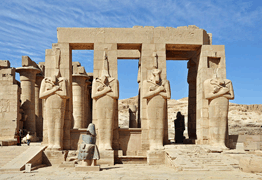 Marc Ryckaert |
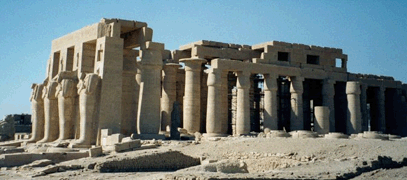 Hajor |
| c.1250 | RAMESEUM, Ramses-II's mortuary temple in Theban necropolis across the Nile from Thebes, 20 years in building, finished. Oriented northwest/southeast, the temple comprised 2 pylons (gateways, 60m wide), one after the other, each leading into a courtyard. Beyond the 2nd courtyard, at the center of the complex, is a covered 48-column hypostyle hall, surrounding the inner sanctuary. | no date: wikRmsm |
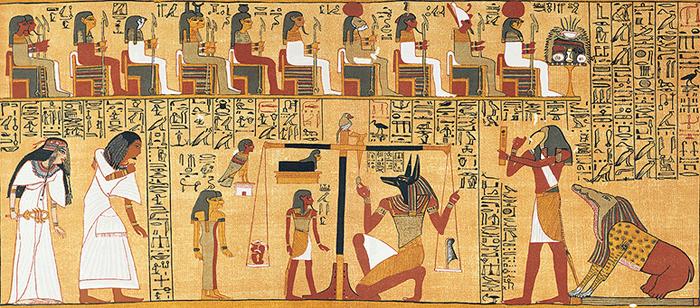 {{PD-US}} |
| c. 1250 | Papyrus of ANI A "Λ Book of the Dead" for scribe Ani of Thebes. Contains declarations and spells to help deceased Ani in the afterlife. Written in cursive hieroglyphs, illustrated with color miniatures. In center is a balance, holding Ani's heart (left) and a feather (right) representing Maat (truth and order). The crossbar of the balance hangs from the upright support. A small baboon (a form of the god Thoth) squats on top. Jackal-headed Anubis holds the cord of the right pan, and steadies the plumb bob of the balance. Right of the balance stands Thoth, here in human form with ibis head; Thoth holds a scribe's palette and a reed brush, ready to note the results of Ani's interrogation. On a mat behind Thoth sits a monster ready to consume Ani's heart if he fails to pass the test. This creature has the head of a crocodile, the forepart of a lion, and the rump of a hippo. |
1250 brtms,
wikLF, wikPA 1240 egyk |
| c.1250 | Λ ASTRONOMY V: At least 43 constellations are familiar to the Egyptians. | 13-1200 aw |
| c.1246 | RAMSES-II marries a Hittite princess. | yr 33 Grim 257 |
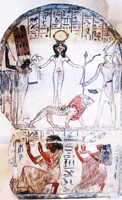 Qetesh stele {{PD-US}} |
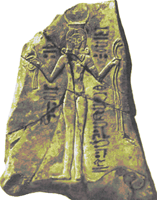 Qetesh relief Camocon | 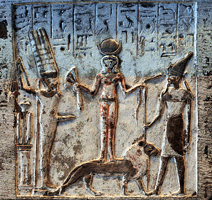 Qetesh stele Rama |
| c. 1240 | Canaanite goddess QETESH (Kadesh) is adopted into Egyptian religion. A fertility goddess of sacred ecstasy and sexual pleasure, represented as a frontal nude wearing the headdress of Hathor and standing on a lion. She holds a lotus flower to Min of Egypt and a snake to Canaanite warrior god Resheph. She is called "Mistress of All the Gods", "Lady of the Stars of Heaven", "Beloved of Ptah", "Great of magic, mistress of the stars", and "Eye of Ra, without her equal". She is associated with Anat, Astarte, and Asherah, and has elements associated with goddesses of Myceneae, Minoans of Crete, and certain Kassite goddesses of the metals trade in tin, copper and bronze between Lothal and Dilmun. | 1292-1186 wikQts |
| c.1235 | RAMSES-II marries a 2nd Hittite princess. | yr 44 Grim 258 |
| c.1235 | SETAU, Ramses' viceroy of Kush, invades Nubia. | R-II yr 44 Grim 259, nar |
| c.1234 | TUDHALIYAS-IV, king of Hittites 1237-09, visits Egypt. | R-II yr 36 Grim 257 |
| c.1230 | SEA PEOPLES begin raiding Levant and Egypt. | 1230 vrb |
| c. 1225 | 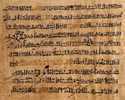 Tale of Two Brothers preserved on D'Orbiney Papyrus: Tale of Two Brothers preserved on D'Orbiney Papyrus:Anubis's wife tries to seduce his bro Bata, fails, and accuses Bata of trying to seduce her. Bata flees, Anubis pursues. Bata castrates himself to prove his innocence. Anubis goes home and kills his wife. A convoluted story follows, suggesting that the original story was expanded over time. |
photo pub dom 1225 Jud 10-203 r. of Seti-II: wikS2, wikT2B |
| c.1224 | KHAEMWASET, crown prince of Egypt, dies, leaving bro Merneptah heir. | R-II yr 55 Grim 268 |
| c.1220 | Λ ASTRONOMY V: Oldest known copies of an almanac. | 1220 aw |
| c.1220 | Ipuwer Papyrus contains Admonitions of Ipuwer Describes Egypt as afflicted by natural disasters and in a state of chaos. Poor have become rich, and the rich poor. War, famine and death are everywhere. Servants are leaving their servitude and acting rebelliously. | 17th cen: wikLAEP 1600 bk contents describe 2nd Intermed. Period MS itself = late 13th cen: wikIP |
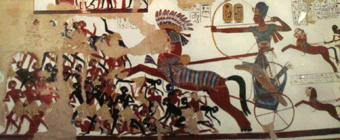 Roderick Dailey |
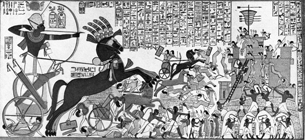 {{PD-US}} |
| c.1213 | RAMSES-II dies age 67-90. Son of Seti-I, 3rd pharaoh of 19th Dyn from 1279. Buried in the Valley of the Kings KV7, but his mummy will be moved to TT320. Weak pharaohs rule until end of dynasty. Son (now in his 60s) MERNEPTAH succeeds until 1203. |
1294 CVK, GEoP, ae 1237 B76 6-475, CAH 2.2, JIAE, RAI3, bk 1236 B76 VI-808 1235 AYGC 159, DHJ 59, SHWC 29 1234 Sdl 1-29, 30, lveg 1232 WERE 1227 ISBE 2-44 1225 BHoE, RAH 82 1223 Jud 13-1545 1213 Shaw, ktut, nar, phou, treg, wikP 1212 Clay, DMoN, Grim, Murn, pic, resh, scar, tig |
| c.1213 | CAPITAL of Egypt: PI-RAMESES from 1279, moved to MEMPHIS until 1070. | 1213 wikNKE |
| c.1209 | MERNEPTAH, pharaoh of 19th Dyn 1213-03, puts down disorder in Canaan. | 1224 MCAW 42 yr 3 BHoE 465 |
| c.1208 | The "NINE BOWS" confederacy under the king of Libya invades the western delta until 1207. | 1221 TTPC 1219 MCAW 42 yr 5 nar yr 5 & 6 Grim 269, wikSP 1208 hifi |
| c. 1207 | The "NINE BOWS" confederacy defeated by Merneptah at Perire. 6,000 killed, 9,000 prisoners taken. | 1285 pczy 1231 B76 17-940 1230 PAE 158, PANE1 231, pczy 1229 Sdl 2-259 1221 TTPC, bk 1219 MCAW 42 1208 hifi yr 5 B76 17-940, BHoE 468, Grim 269, PANE1 231, pczy yr 5 & 6 wikSP |
| Recorded in 4 inscriptions of Merneptah, who says he killed 6,000 soldiers and took 9,000 prisoners, 9,000 swords. His Karnak Inscription indicates that this coalition included Sea Peoples. "Danya, Ekwesh, Teresh, Tjekker, Lukka, Sherden (Sardinians?), Shekelesh (Sicilians?), Northerners coming from all lands." Lukka (Lycians) are also mentioned. |
| c. 1207 |  Merneptah Stele (aka Israel Stele) , a black granite slab, over 3m high. Mostly glorifies Merneptah"s victories over Libyans and their Sea People allies, but the final 2 lines mention a campaign in Canaan, where Merneptah says he defeated and destroyed Ashkalon, Gezer, Yanoam and Israel. "Israel is laid waste; his seed is not. Palestine has become a widow for Egypt." . This is the 1st known mention of Israel. Discovered in Thebes.
Merneptah Stele (aka Israel Stele) , a black granite slab, over 3m high. Mostly glorifies Merneptah"s victories over Libyans and their Sea People allies, but the final 2 lines mention a campaign in Canaan, where Merneptah says he defeated and destroyed Ashkalon, Gezer, Yanoam and Israel. "Israel is laid waste; his seed is not. Palestine has become a widow for Egypt." . This is the 1st known mention of Israel. Discovered in Thebes. |
Webscribe yr 5 DHJ 79, wikMS 1229 IDB 1-584 1209 wikLABA |
| c. 1203 |  MERNEPTAH dies. Son of Ramses-II, 4th pharaoh of 19th Dyn from 1213. Buried in Valley of the Kings KV8 in 4 nested sarcophagi, the outer one being the biggest ever discovered. Yet somehow his mummy will be removed to the mummy cache in KV35 of Amenhotep II.
MERNEPTAH dies. Son of Ramses-II, 4th pharaoh of 19th Dyn from 1213. Buried in Valley of the Kings KV8 in 4 nested sarcophagi, the outer one being the biggest ever discovered. Yet somehow his mummy will be removed to the mummy cache in KV35 of Amenhotep II.Possible usurper AMENMESSE may succeed, or may be regent for next pharaoh until 1199. |
photo: Hajor 1223 B76 VI-808, 6-475, CAH 2.2, JIAE 1220 Sdl 1-30 1217 ISBE 2-44 1216 lveg 1215 BHoE, DHJ 59 1214 CVK, GEoP, ae 1209 RAI3 1203 Shaw, ktut, phou, treg, wikP 1202 Clay, Grim, Murn, nar, pic, resh, scar, tig 1201 DMoN |
| c.1200 | CANAAN, under Egypt from 1274, is now free of Egyptian domination. | guess |
| c.1200 | SEMITES in Egypt, remaining after Exodus, migrate north. | 1200 TTPC 8 |
| c.1200 | 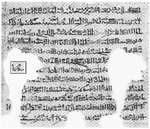 Cairo Calendar records passage of stars to predict the future in terms of favorable and unfavorable days.
Cairo Calendar records passage of stars to predict the future in terms of favorable and unfavorable days.Λ ASTRONOMY V: Allegedly shows a binary star in the Perseus constellation. (See Babylonia 1200) |
photo: pub dom 1200 wik |
| c.1200 |  Λ GEOMETRY: 3-4-5 RIGHT TRIANGLE used by surveyors. 1st usage may be much earlier. (See Plimpton Tablet 1800, also China 1000)
Λ GEOMETRY: 3-4-5 RIGHT TRIANGLE used by surveyors. 1st usage may be much earlier. (See Plimpton Tablet 1800, also China 1000) |
1200 TTT |
| c.1200 | Chester Beatty Λ Medical V Papyrus Written in hieratic, contains magical incantations against headaches and remedies for rectal ailments. Started as a private collection by scribe Qen-her-khepeshef in the 19th Dynasty, passed down thru his family, placed in a tomb. | 1200 wikCBMP, wikEMP |
| c.1200 | 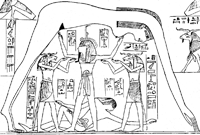 UMBRELLA used in Mesopotamia from 1400, acquires religious significance in Egypt. Goddess NUT is represented as an umbrella-like covering of the earth. Man made umbrellas become embodyments of Nut.
UMBRELLA used in Mesopotamia from 1400, acquires religious significance in Egypt. Goddess NUT is represented as an umbrella-like covering of the earth. Man made umbrellas become embodyments of Nut. |
photo retouched: {{PD-US}} 1200 EOET 318 |
| c.1200 | Λ GLASS making: An active industry in Egypt and Mesopotamia from at least 1550, declines in Egypt until 550. | 1200 txgls |
| c.1199 | AMENMESSE dies. Regent or usurper pharaoh of 19th Dyn from 1203. Buried in Valley of the Kings KV10. But almost all of its texts and scenes are erased or usurped by agents of Seti-II, son of Merneptah. SETI-II succeeds until 1194. | 1217 B76 6-476, CAH 2.2, JIAE 1216 lveg 1214 ae 1210 CVK 1200 Shaw, phou, treg, wikP 1199 Clay, Grim, Murn, ktut, pic, resh, scar, tig, wikAm 1196 DMoN, nar SIPTAH succeeds: BHoE |
| c.1198 | SETI-II, pharaoh of 19th Dyn, abandons SET worship in favor of OSIRIS. | no date: NLEM 20 |
| c.1198 | SHASU tribes of Edom cross into Egypt during reign of Seti-II 1199-94. | 1205 WPOT 231 |
| c.1194 | SETI-II dies. Son of Merneptah, pharaoh of 19th Dyn from 1199. Buried in unfinished tomb KV15. Possible only son SIPTAH succeeds until 1188. Widow of Seti-II, TWOSRET (Tausert) is regent. |
1210 B76 6-476, CAH 2.2, JIAE 1208 GEoP 1204 CVK, ae 1197 lveg, wikP, wikS2 1196 Grim 1195 DMoN, nar 1194 Shaw, phou, treg 1193 Clay, Murn, ktut, pic, resh, scar, tig |
| c.1194 | SIPTAH, pharaoh 1194-88, goes to NUBIA to install his viceroy, SETI. | yr 1 BHoE 473 |
| c.1190 | Inscription in 4th year of SIPTAH shows Chancellor Bay's last appearance in public. | yr 4 wikSpt |
| c.1189 | CHANCELLOR BAY executed on orders of Siptah. | yr 5 wikSpt |
| c.1189 | TWOSRET, regent for pharaoh Siptah, assumes royal titles. | Siptah yr 5 DMoN 140 |
| c.1188 | 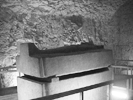 SIPTAH dies age @16. Possible son of Seti-II, pharaoh of 19th Dyn from 1194. Buried in Valley of the Kings KV47 (an undecorated cave). His mummy will be moved to the cache at KV35.
SIPTAH dies age @16. Possible son of Seti-II, pharaoh of 19th Dyn from 1194. Buried in Valley of the Kings KV47 (an undecorated cave). His mummy will be moved to the cache at KV35.Stepmom TWOSRET succeeds until 1186. |
pub dom 1203 B76 6-476 1202 GEoP 1200 CAH 2.2 1198 CVK, ae 1191 wikP 1190 Grim 1189 DMoN, nar 1188 MRDK, Shaw, phou, treg 1187 Clay, Murn, ktut, pic, resh, scar, tig |
| c.1186 | 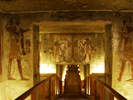 TWOSRET dies. Widow of Seti-II, pharaoh of 19th Dyn from 1188. Buried in Valley of the Kings KV14, a tomb made for her during reign of Seti-II.
TWOSRET dies. Widow of Seti-II, pharaoh of 19th Dyn from 1188. Buried in Valley of the Kings KV14, a tomb made for her during reign of Seti-II. |
pub dom 1200 B76 6-476, CAH 2.2 1196 CVK, ae 1194 GEoP 1190 wikP 1188 Grim, nar 1187 DMoN 1186 MRDK, Shaw, ktut, phou 1185 Clay, Murn, pic, resh, scar, tig, treg |
| c.1186 | 19th DYNASTY ends. Began 1293. | 1200 CAH 2.2, DHJ 79, JIAE, Sdl 2-74, 80 1197 lveg 1196 CVK, ae 1188 Grim, nar 1186 MRDK, Shaw, ktut, phou, wikP 1185 Clay, Murn, pic, resh, tig, treg |
|---|---|---|
| 20th DYNASTY begins until 1070. | ||
| c.1186 | SETNACHT ascends. (of unknown origin) becomes 1st pharaoh of 20th Dyn until 1184. Claims to have "driven out the usurper". Refuses to acknowledge Siptah and Twosret, but claims to have succeeded Seti-II. |
1200 B76 6-476, CAH 2.2, ISBE 2-44, JIAE, WERE 1197 lveg 1196 CVK, ae 1190 wikP 1188 Grim, nar 1187 DMoN 1186 MRDK, Shaw, ktut, phou, treg 1185 Clay, Murn, pic, resh, scar, tig 1184 GEoP |
| c.1186 | SETNACHT starts on tomb KV11 in Valley of the Kings, but stops when diggers accidentally brake into the tomb of 19th Dynasty pharaoh Amenmesse. Setnakhte then appropriates KV14 of his predecessor Twosret for his own use. | no date: wikStn |
| c.1184 |  SETNACHT dies. 1st pharaoh of 20th Dyn from 1186. Buried in Valley of the Kings KV14. SETNACHT dies. 1st pharaoh of 20th Dyn from 1186. Buried in Valley of the Kings KV14.Son RAMSES-III succeeds until 1153. |
photo: pub dom 1198 B76 VIII-410, 6-476, BHoE, CAH 2.2, ISBE 2-44, JIAE, RAH 82, WERE, pczy 1197 Sdl 1-30, 164 1195 lveg 1194 CVK, ae 1188 Jud 13-1545 1186 Grim, nar, wikP, wikStn 1185 DMoN 1184 MRDK, Shaw, bk, phou, treg 1182 Clay, GEoP, Murn, ktut, pic, resh, scar, tig |
| c.1179 | RAMSES-III defeats a land and sea attack in the Delta by LIBYANS and SEA PEOPLES, including at least the Peleset and Tjeker. | 1194 Sdl 1-173 1188 yr 8 IDB 3-791 1187 yr 5 wikSP yr 5 B76 6-476, BHoE 479, DMoN 142, nar, pczy 1179 hifi |
| c.1176 | SEA PEOPLES, including Peleset, Teresh, Tjeker, Shekelesh, Denyen, and also Weshesh (Libyans) invade Egypt, camp in Amor and send a fleet to the Nile. RAMSES-III ambushes the fleet and defeats the land force at his border. He takes chiefs captive: from Hatti, Amor, and Shasu. | 1190 B76 17-941
1176 hifi 1174 RAI2 yr 8 B76 17-941, DMoN 143, Grim 272, pczy, wikSP |
| c.1176 | SEA PEOPLES' conquest is recorded in Medinet Habu inscription of Ramses-III, by means of a net drawn across the mouth of a river. "The foreign countries made a plot in their islands, and all the lands were removed and scattered by battle all at once. No land could stand before their arms, from Hatti, Kode, Arzawa, Carchemish, Alashiya (Cyprus?) on being cut off." The Peleset and Tjekker warriors who fought in the land battle against Ramses-III are accompanied in the reliefs by women and children loaded in ox-carts with Λ solid wheels. |
1200 SHT 1-209 1190 B76 17-941, WPOT 56 1176 MCAW 46 1175 wikSP 1174 MCAW 47 yr 8 B76 17-941, pczy, wikSP |
| c.1173 | Libyans and Sea Peoples led by Meshwesh tribe again invade Delta. | R-3 yr 11 BHoE 481, nar |
| c.1172 | RAMSES-III, pharaoh 1184-53, defeats SEA PEOPLES and Libyans. | 1188 PANE 1-185 1187 IDB 1-399, 4-11, MCAW 46 yr 12 wikSP 1172 hifi 1170 PAE 159 |
| Stele mentions the Tjeker, Peleset, Denyen, Shekelesh, and Weshesh in land battle at DJAHY in Canaan. |
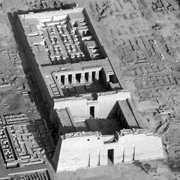 Steve F-E-Cameron |
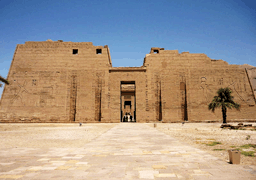 Rémih |
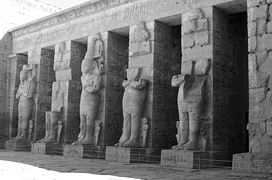 Steve F-E-Cameron |
| c.1172 | MEDINET HABU temple and palace finished by RAMSES-III, pharaoh 1184-53. | 1174 MCAW 47 after yr 11 mclng yr 12 BHoE 492 |
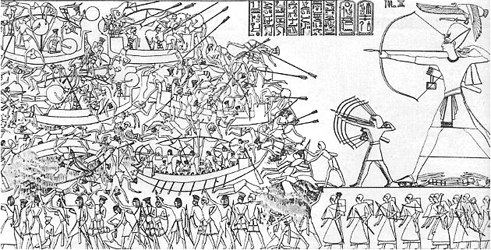 {{PD-US}} |
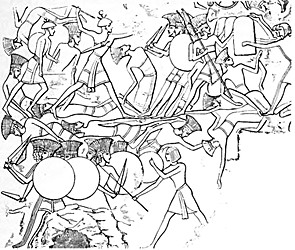 {{PD-US}} |
| c.1172 | MEDINET HABU walls show Ramses-III' defeating Sea Peoples. | 1174 MCAW 47 after yr 11 mclng yr 12 BHoE 492 |
| c.1170 | 1st recorded STRIKE by pyramid workers at Thebes, because of bad food, lack of ointments, and delayed payroll. | 1170 TTPC 8, bk yr 29 DMoN 146 no date: SHT 1-286 |
| c.1160 | SHASU of Seir cross into Egypt during reign of Ramses-III. | 1180 WPOT 231 |
| c.1160 | RAMSES-III makes abortive attempt to recover Aram. | no date: MCAW 46 |
| c.1160 | HAREM PLOT to replace RAMSES-III with prince Pentewere is discovered and exposed to the legal heir Ramses(4). | yr 32 nar |
| c. 1160 c. 1160 |
Turin Papyrus includes: Map, King List, Judicial Papyrus, Erotic Papyrus. {{PD-US}} {{PD-US}} Map oldest surviving topographical map, made for Ramses-IV's quarrying expedition to Wadi Hammamat in Eastern Desert.
Turin King List believed to be the most extensive list of Egyptian kings, and is basis for most chronology before Ramses-II. Beginning and ending are lost.
Judicial Papyrus record of trials against conspirators plotting to assassinate Ramses-III in "Harem Conspiracy". Mostly summaries of accusations, convictions, and punishments. Erotic Papyrus Scroll-painting 2.6m by 25cm, contains 12 vignettes of various sex positions. Men are scruffy, balding, short, paunchy, with large genitalia. Women are nubile. The only extant erotic scroll-painting. |
1200 Sdl 3-438 1160 wikTP |
| KV11 | ||
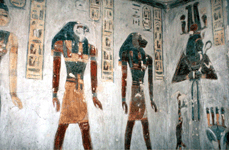 Peter J. Bubenik |
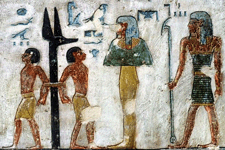 {{PD-US}} |
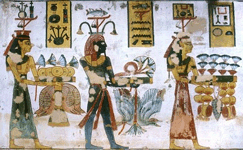 {{PD-US}} |
| c.1153 | Son of Setnacht, RAMSES-III dies. 2nd pharaoh of 20th Dyn from 1184, murdered in or after after a harem conspiracy. Buried in KV11, one of the largest in the Valley of the Kings, started by Setnakhte, but abandoned when it broke into the earlier tomb of Amenmesse. Oldest surviving son RAMSES-IV succeeds until 1146. |
1167 BHoE, RAH 82, WERE 1166 B76 VIII-410, 6-476, CAH 2.2, JIAE, RAI3, bk, pczy 1165 Sdl 1-30, 164 1164 lveg 1163 CVK, ae 1157 Jud 13-1545 1155 wikP, wikR3 1154 Grim, nar 1153 DMoN, MRDK, Shaw, phou, treg 1151 Clay, GEoP, Murn, RAI2, Sag, ktut, pic, resh, scar, tig |
| c.1151 | RAMSES-IV visits quarries at Wadi Hammamat. | yr 2 BHoE 507 |
| c.1150 | MERCENARIES formerly employed by Ramses-III, settle in delta cities. | no date: BHoE 19 |
| c. 1150 | Harris Papyrus-1 , 41m long with @1,500 lines of hieratic text, consists of a list of temple endowments and a brief summary of the entire reign of Ramses-III."As for those who reached my frontier, their seed is not, their heart and their soul are finished forever and ever. As for those who came forward together on the seas, the full flame was in front of them at the Nile mouths, while a stockade of lances surrounded them on the shore, prostrated on the beach, slain, and made into heaps from head to tail."The Edomites too were subjugated. In the west he stopped the incursions of the Libyans and Meshwesh and settled them in the western Nile delta. Ramses-III claims that he made subjects of the Sea Peoples and settled them in southern Canaan. "I sent my emissaries to the land of Atika, [Timna] to the great copper mines which are there. Their ships carried them along and others went overland on their donkeys. It had not been heard of since the (time of any earlier) king. Their mines were found and (they) yielded copper which was loaded by tens of thousands into their ships, they being sent in their care to Egypt, and arriving safely."Also mentions that Setnakhte, R-III's father, restored order to Egypt after civil conflict, expelling Asiatic followers of Irsu. But the text is prepared by Ramses-IV to show his great works, and temple wealth. Lists 30 forms of bread and cakes. Beans, peas, & lentils are eaten, but subject to taboos |
1200 SHT 1-271 1167 EIHM 39 no date: wikPH1, wikR3 |
| c.1150 | Thanks to Hittites
, IRON is now in general use everywhere in the Mediterranean except Egypt, which uses it, but clings to traditional bronze. (See 1200 in Europe, Levant, Persia) |
1200 SHT 1-596 1150 WPOT 93 |
| c.1150 | EGYPTIAN Λ MEDICINE V is divided into 2 schools:
1. Fevers, pain, & tumors are diseases treatable by expensive physicians.
2. It's all caused by demons which can be expelled by cheap priests.
Physicians and priests both prescribe enemas, purgatives, special diets, herbs, poultices of animal fat. |
1150 TTPC 8 |
| c.1150 | ECONOMY: Price of wheat rises 8-24 times its original price from 1182-1127, and stays inflated for remainder of century. | 1182-1127 pczy |
| c. 1149 | Wilbour Papyrus land survey and tax assessment document covering lands from Crocodilopolis south almost to modern El-Minya (90 miles). Includes taxation, information about late Ramesside administrative practices, temple economy, population, occupations and land donated to deities. Shows most land is controlled by Amun priests, who also direct finances. 14% of cultivable land between Fayyum and Assiut is assigned to Amun temples. | 1150 CAH 7.1-132 R-5 yr 4: wikR5 no date: wikWP |
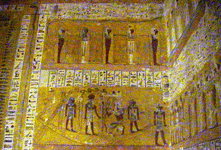 pub dom |
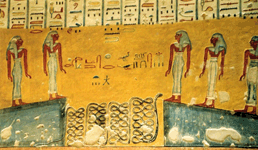 Eigene Aufnahme |
| c.1146 | RAMSES-IV dies age c.50. 5th son of R-III, 3rd pharaoh of 20th Dyn from 1153. Buried in Valley of the Kings KV2. His mummy will be moved to the royal cache KV35. Son RAMSES-V succeeds until 1142. |
1161 BHoE 1160 B76 VIII-410, 6-476, JIAE 1156 CVK, ae 1149 wikP, wikR4 1148 CAH 2.2, Grim 1147 Shaw, nar, phou, treg 1146 DMoN 1145 Clay, Murn, ktut, pic, resh, scar, tig 1134 GEoP |
| c.1145 | Workmen at Deir el-Medina periodically stop work on Ramesses-V's KV9 tomb out of fear of "the enemy", presumably Libyan raiding parties, who had reached the town of Per-Nebyt and "burnt its people". Another incursion by these raiders Thebes into Thebes is recorded a few days later. | yr 1 wikR5 |
| c.1145 | Debris from digging KV9 is dumped over the entrance to Tut's tomb, protecting it from robbers. | no date: wikR6 |
| c.1142 | RAMSES-V dies of smallpox, age 30-35. Son of Ramses-IV, 4th pharaoh of 20th Dyn from 1153. He will not be buried until year 2 of the following reign. A son of R-III, RAMSES-VI succeeds until 1134. | 1156 B76 VIII-410, 6-476, CAH 2.2, JIAE 1151 CVK, ae 1145 wikP, wikR5 1144 Grim 1143 Shaw, phou, toreg 1142 MRDK, nar 1141 Clay, CWH, DMoN, GEoP, Murn, ktut, pic, resh, scar, tig |
| c.1140 | Mummy of Ramses-5 buried in Valley of the Kings KV9, which is highly irregular since tradition required a king to be mummified and buried precisely 70 days into the reign of his successor. Ramses-VI will commandeer KV9 for himself. | R-6 yr 2 wikR5 |
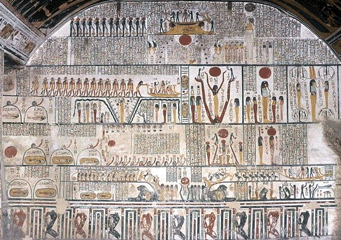 pub dom Book of Earth |
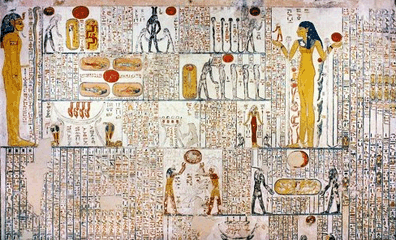 pub dom Book of Caverns |
| c.1134 | RAMSES-VI dies. Son of R-III, 4th pharaoh of 20th Dyn from 1153. Buried in KV9 along with R-V. KV9 contains funerary texts: Book of Earth describing the creation of the solar disk Ra, and Book of Caverns describing the journey of Ra thru the 6 caverns of the underworld, focusing on rewards and punishments in the afterlife. Son RAMSES-VII succeeds until 1128. | 1148 B76 VIII-411, 6-477, CAH 2.2, JIAE 1143 CVK, ae 1137 wikP, wikR6 1136 Grim, Shaw, phou, treg 1135 MRDK 1134 GEoP, nar, pic 1133 Clay, DMoN, Murn, ktut, resh, scar, tig |
| c.1134 | Λ ASTRONOMY: STAR TABLE V is on ceiling of tomb of Ramses-VI. | no date: wikEA |
| c.1134 | Shortly after burial, R-VI's tomb is ransacked by thieves who hack at his hands and feet to get his jewelry. His mummy, will be found in KV35 and reveal severe damage to his body, with the head and torso broken into several pieces by an axe. | 1137 wikR6 |
| c.1128 | Turin Accounting Papyrus created. Records the commissioning of some copper work and mentions 2 foreman at Deir El-Medina: Nekhemmut and Hor[mose]. | R-7 yr 7 wikR7 |
 pub dom |
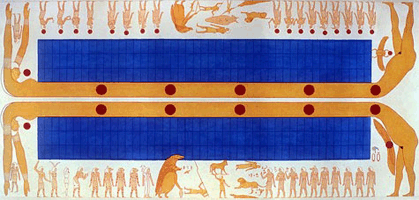 {{PD-US}} Double image of sky goddess Nut on ceiling |
| c.1128 | RAMSES-VII dies. Son of Ramses-VI, 6th pharaoh of 20th Dyn from 1134. Buried in east Valley of the Kings KV1 containing funerary texts: Book of Earth, Book of Caverns, Book of Gates, and a double image of sky goddess Nut on the ceiling. Mummy never found. Son of R-III, RAMSES-VIII succeeds until 1126. |
1147 B76 VIII-411, CAH 2.2 1141 JIAE 1136 CVK, ae 1134 GEoP 1133 pic 1130 wikP 1129 Shaw, phou, treg, wikR7 1128 Grim, resh 1126 Clay, Murn, nar, scar 1125 DMoN, ktut, tig |
| c.1126 | RAMSES-VIII dies. 7th pharaoh of 20th Dyn from 1128, dies. Tomb never found. RAMSES-IX succeeds until 1108. | 1142 BHoE 1140 B76 VIII-411, CAH 2.2, JIAE 1134 GEoP 1131 CVK, ae 1129 wikP, wikR8 1126 Shaw, phou, pic, resh, scar, tig, treg 1125 Grim 1124 ktut, nar 1123 DMoN |
| c.1116 | AMENHOTEP, high priest of Amon at thebes, given much wealth by Ramses-IX. Some regular payments made to pharaoh are transferred to treasury of Amon. | yr 10 BHoE 508 |
| c.1110 | HIGH PRIESTS of Amon shown on monuments equal in height to Ramses-IX, implying that they are equal in power. | 1110 MCAW 46 |
| c.1110 | Tomb of Sobekemsaf-I and other royal tombs in western Theban necropolis are robbed. Investigation implicates royal officials. Recorded in Abbott Papyrus, Amherst Papyrus and Mayer Papyri. | R-9 yr 16 BHoE 510, Grim 289, wikR9 |
| c.1110 | Much PAPYRUS shipped from Egypt to Gebal (Byblos). | just before 1100 BBP 14 |
| c.1110 | Amherst Papyrus Court records dealing with tomb robberies under Ramesses-IX. Confessions of 8 robbers are elicited by beating with a double rod, smiting feet and hands. They are impaled - the standard tomb-robbing punishment. | R-9 yr 16 wikAP |
| c.1108 | Six men are convicted of robbing tombs of Seti-I and Ramses-II. | yr 19 BHoE 510 |
| RAMSES-IX makes son Ramses co-king. |
| c.1108 | RAMSES-IX dies. 7th pharaoh of 20th Dyn from 1126. Buried in KV6. His mummy will be found in Deir el-Bahri cache DB320. RAMSES-X succeeds until 1098. All that is known of him is that the insecurity and tomb robberies, prevalent under his predecessors, continue to grow under him. |
1123 BHoE, JIAE 1121 B76 VIII-411, 6-477, CAH 2.2 1117 GEoP 1112 CVK, ae 1111 wikP, wikR9 1108 Clay, Murn, Shaw, phou, pic, resh, scar, tig, treg 1107 Grim 1106 ktut 1105 nar 1104 DMoN |
| c.1108 | ASTRONOMY V: Λ STAR TABLE is on ceiling of tomb of Ramses-IX. | no date: wikEA |
| c.1107 | Mayer Papyri Vizier of the South and 3 high officials examine 6 suspected tomb robbers at Deir el-Bahri. Confessions are corroborated by the police chief of the Theban Necropolis and other witnesses, among them the son of one of the thieves. This witness had been a child at the time of the crime; still, he was beaten when examined, as was a female witness. | R-10 yr 1: wikAP |
| c.1100 | Abbott Papyrus 218cm wide and 42.5cm high, written in hieratic. Mayors of the East and West Banks of Thebes investigate tomb robberies. | 1100 wikAbP |
| c. 1100 | Instruction of Amenemope written in 30 numbered chapters by scribe Amenemope son of Kanakht at Akhmim. Discourses in traditional form of instructions from father to son on how to live a successful and moral life. Contains many parallels to Book of Proverbs: Am 30:539: Look to these 30 chapters; they inform, they educate. Pr 22:20: Have I not written for you 30 sayings of counsel and knowledge? Am 2: Beware of robbing the poor, and oppressing the afflicted. Pr 22:22: Rob not the poor, for he is poor, neither oppress the lowly in the gate. Am 7: Toil not after riches; If stolen goods are brought to you, they remain not over night with you. They have made themselves wings like geese. And have flown into the heavens. Pr 23:4-5: Toil not to become rich. And cease from dishonest gain. For wealth makes to itself wings, Like an eagle that fly heavenward. |
1300 -1075 wikIoA 1200 bk 1100 wikAmn and more ... |
| c.1100 | Λ ASTRONOMY: Amenhope writes "Catalog of the Universe" . Identifies the major known constellations. | 1220 aw |
| c.1098 | RAMSES-X dies. 8th pharaoh of 20th Dyn from 1108. His KV18 tomb in Valley of the Kings is unfinished, and it is uncertain if he was ever buried here, since nothing was discovered in it. Son RAMSES-XI succeeds until 1070. | 1121 BHoE 1114 JIAE, GEoP 1113 B76 VIII-411, 6-477, CAH 2.2 1112 ae 1107 wikP, wikRX 1102 ktut 1101 nar 1100 CVK 1099 Shaw, phou, treg 1098 Clay, Grim, pic, resh, scar, tig 1094 DMoN |
| c.1094 | WENAMON, Egyptian envoy, sent to BYBLOS to buy timber for Ramses-XI. He is robbed, and arrives without credentials or gifts. He notifies his superiors who send more trading goods, and Wenamon buys his timber. | 1100 IDB 3-802, 4-722 1091 MCAW 51 1080 SOTS 115 R-11 yr 5: wikWnmn 1079 B76 17-944 1060 AYGC 212, WBANE 342 1050 IDB 3-792 |
| c.1080 | HERIHOR, general under Ramses-XI, appointed High Priest of Amun at Thebes until 1074. Becomes a counter-pharaoh, creating a theocracy. | 1095 MCAW 50 1090 BHoE 1080 Clay, ae, nar, resh, scar, tig, treg no date: JIAE, phou |
| c.1074 | HERIHOR, High Priest of Amun at Thebes from 1080, ends. Son-in-law PIANKH succeeds until 1070. |
1080 Clay, ae, nar, resh, scar, tig, treg no date: JIAE, phou |
| c.1070 | RAMSES-XI dies. Son of Ramses-X, 9th pharaoh of 20th Dyn from 1098. Buried in KV4 in Lower Egypt by Smendes, because he who buried the king customarily inherited the throne. | 1118 BHoE 1087 CWH, GEoP 1085 B76 VIII-411, 6-477, CAH 2.2, JIAE, lveg 1078/7 wikR11 1077 wikP 1070 Clay, CVK, Murn, ae, pic, resh, scar, tig 1069 Grim, MRDK, Shaw, ktut, nar, phou, treg 1064 DMoN R-12 succeeds: BHoE |
| c.1070 | 20th DYNASTY ends. Began 1186. | 1200 SHWC 22 1090 Sdl 2-74 1087 GEoP 1085 CAH 2.2, ISBE 2-41, JIAE, RAH 72, SOTS 44, lveg 1070 Clay, CVK, Murn, ae, pic, resh, tig 1069 Grim, MRDK, Murn, Shaw, ktut, nar, phou, treg, wikP 1064 DMoN |
|---|---|---|
| NEW KINGDOM ends. Began 1550. | ||
| 3rd INTERMEDIATE PERIOD begins until 715 or 656. |
| c.1070 | SMENDES ascends. Son? of Herihor, governor of Tanis, forms a separate kingdom in the delta, becomes 1st pharaoh of 21st Dyn until 1043. | 1090 BHoE 1085 CAH 2.2, ISBE 2-44, JIAE, RAI3, Sdl 3-309, WPOT 94, lveg 1077 wikP 1070 CVK, ae, frN, ktut, nar, pic, resh, tig, treg 1069 Clay, Grim, MRDK, Murn, Shaw, phou |
| c.1070 | CAPITAL of Egypt: MEMPHIS from 1213, moved to TANIS until 715. | 1077 wikNKE |
| c.1070 | 21st DYNASTY begins at Tanis until 945. | 1085 B76 6-479, CAH 2.2, JIAE, WERE, lveg 1070 CVK, ae, nar, pic, resh, tig, treg 1069 Clay, Grim, MRDK, Shaw, ktut, phou, wikP |
|---|
| c.1070 | PIANKH, High Priest of Amun at Thebes from 1074, ends. Son PINUDJEM-I succeeds until 1054. | 1070 Clay, Grim, Murn, ae, nar, pic, resh, scar, tig, treg, wikPi no date: JIAE |
| c.1070 | SILK, probably from China, appears in an Egyptian tomb. | 1070 snslk, wikS, wikSR 1000 TTT |
3rd INTERMEDIATE PERIOD
V
